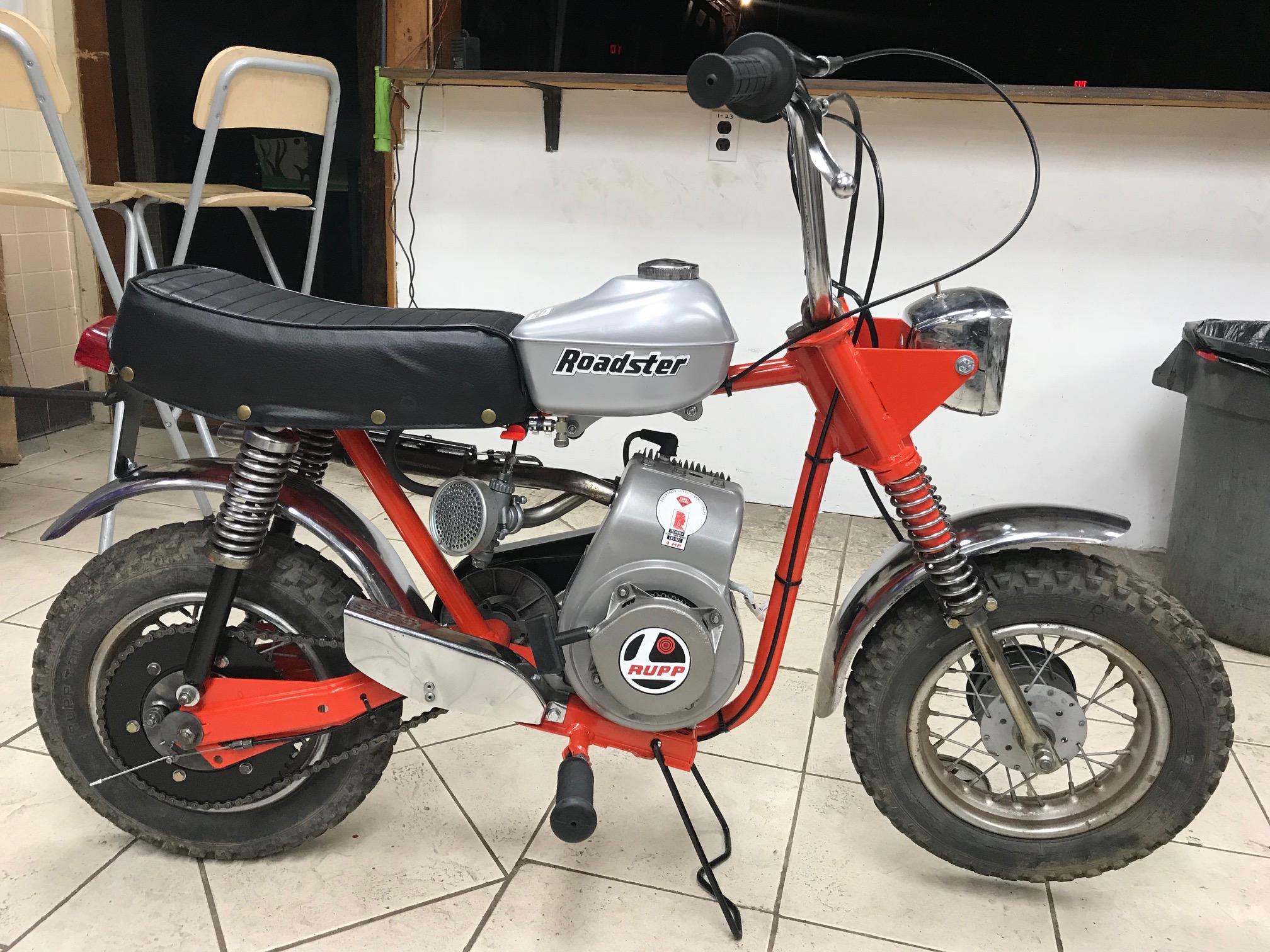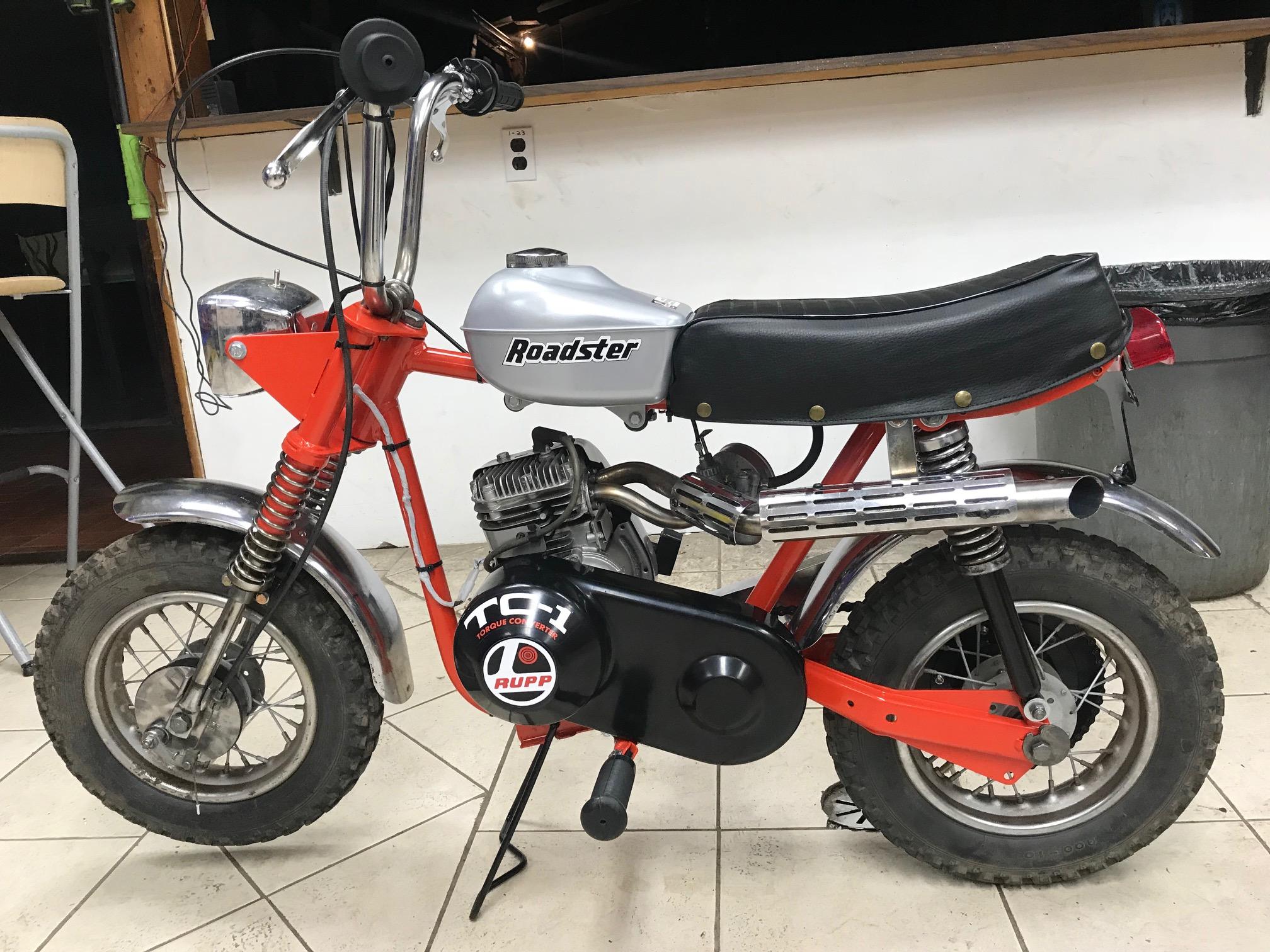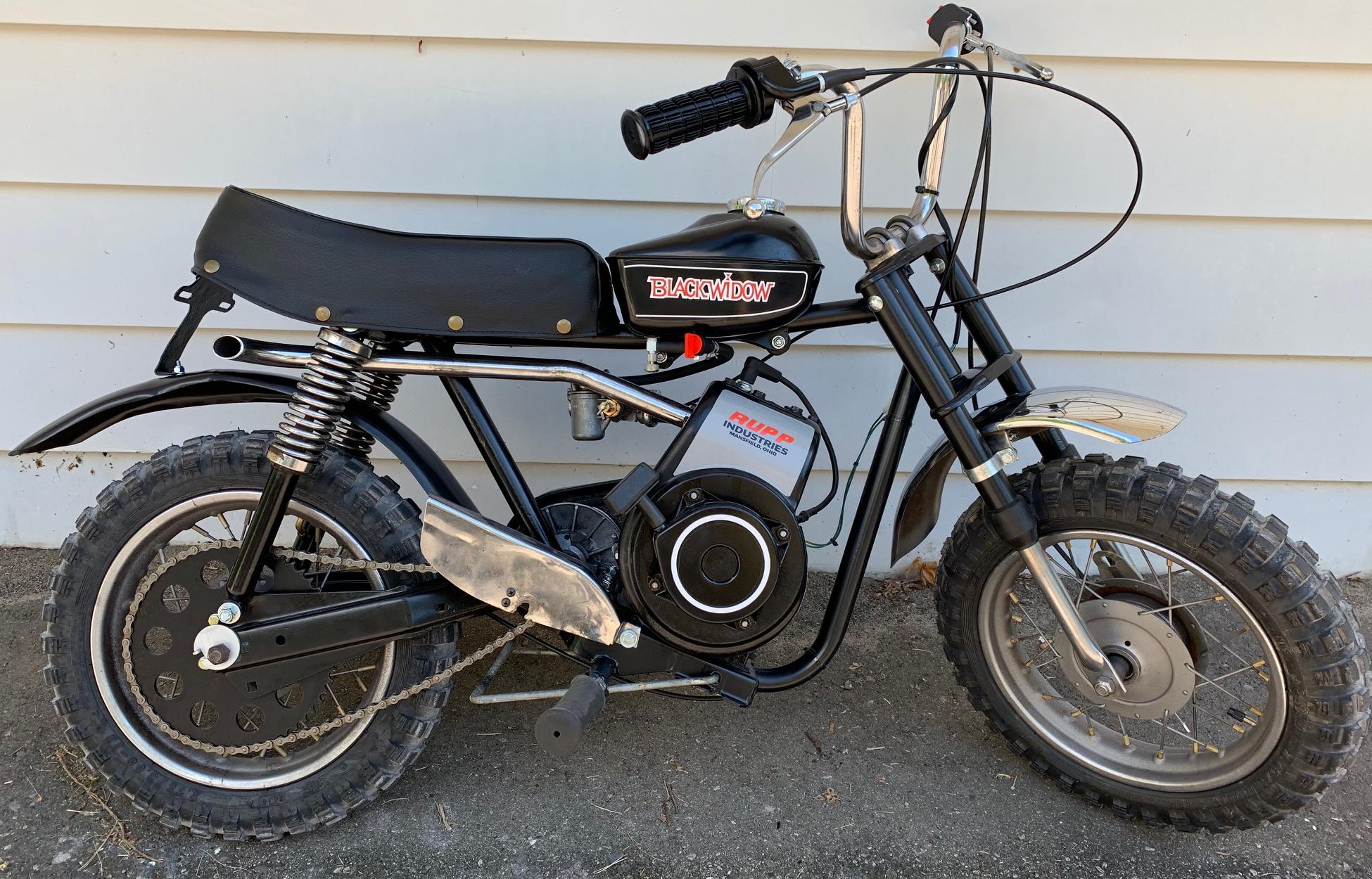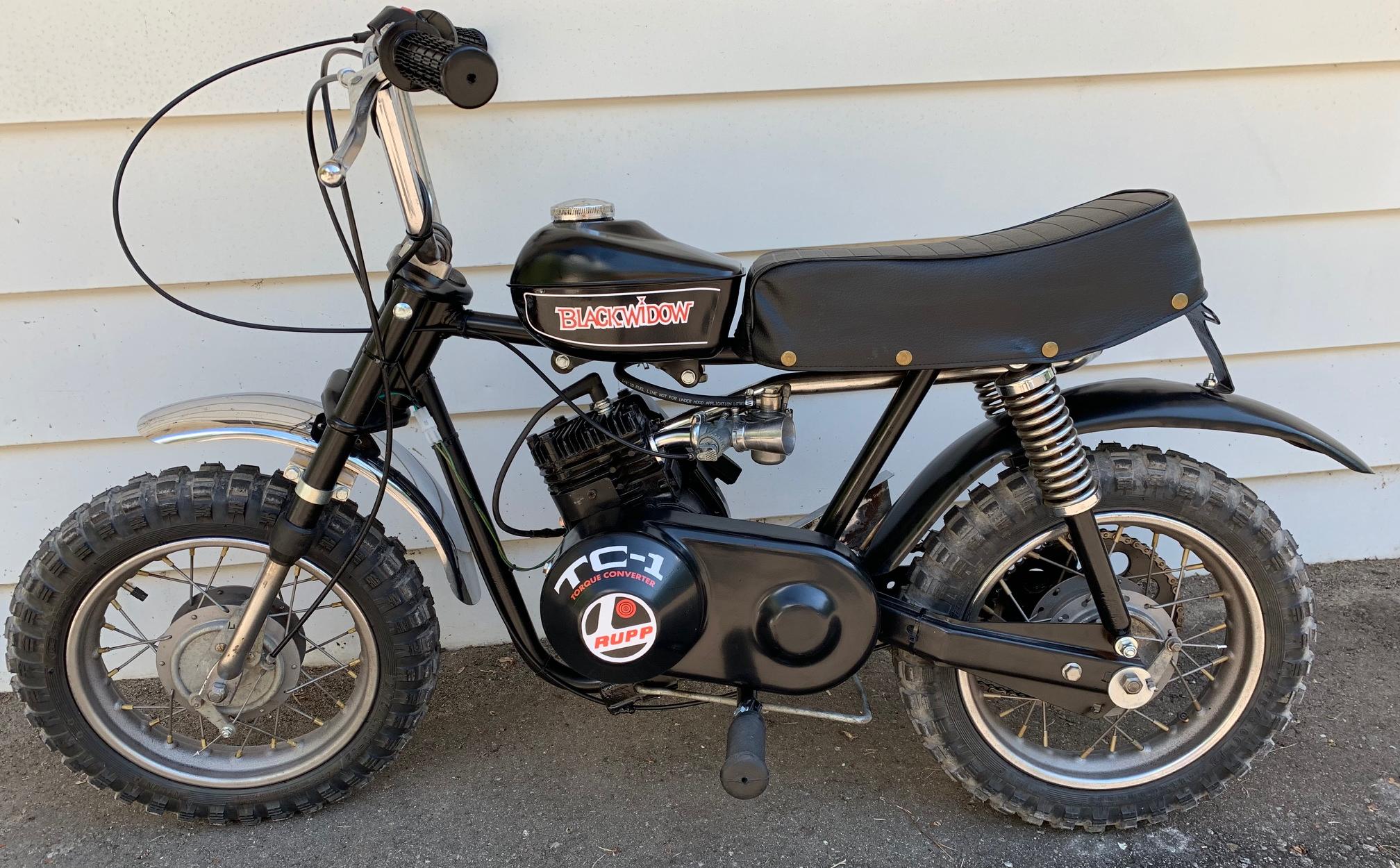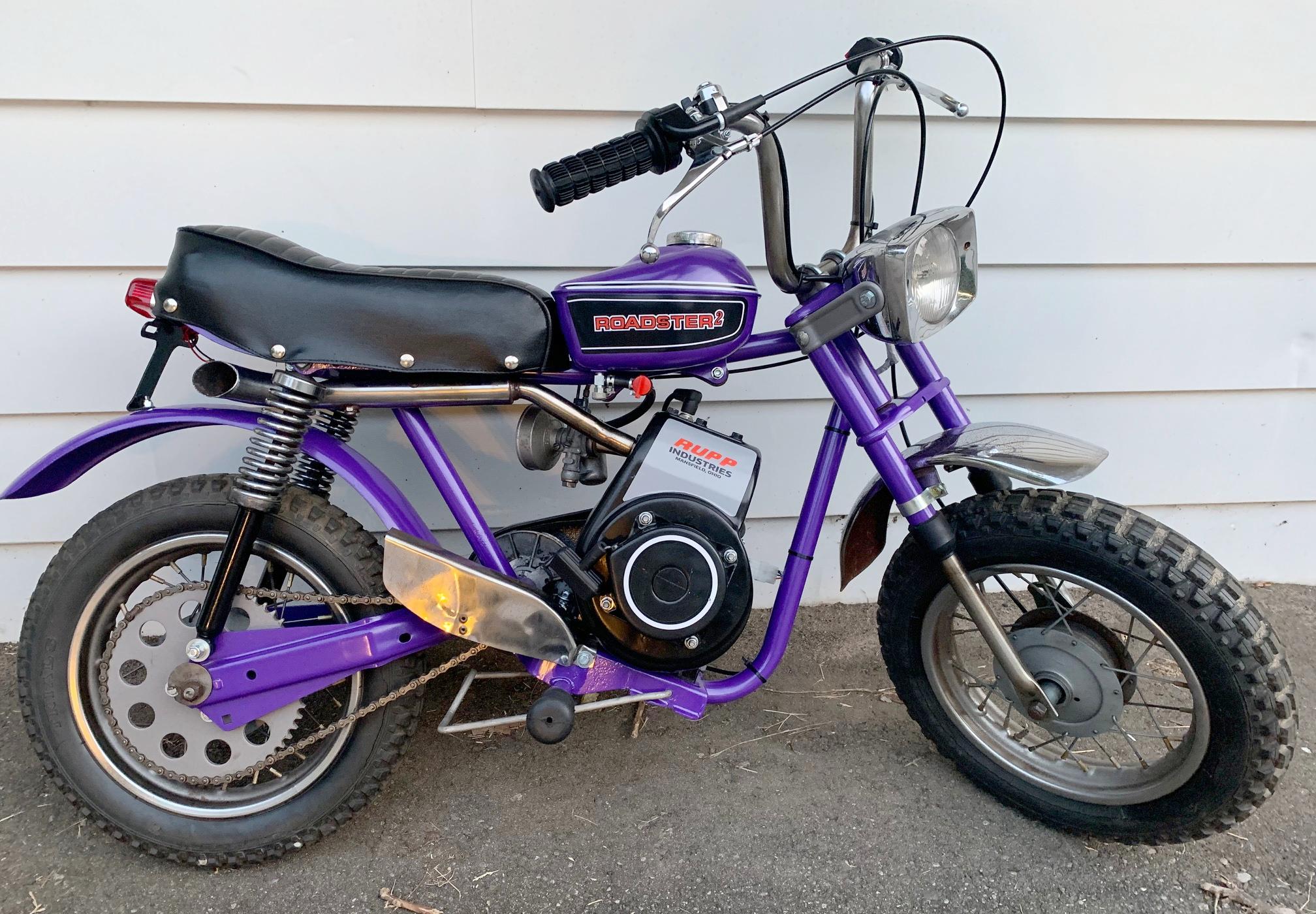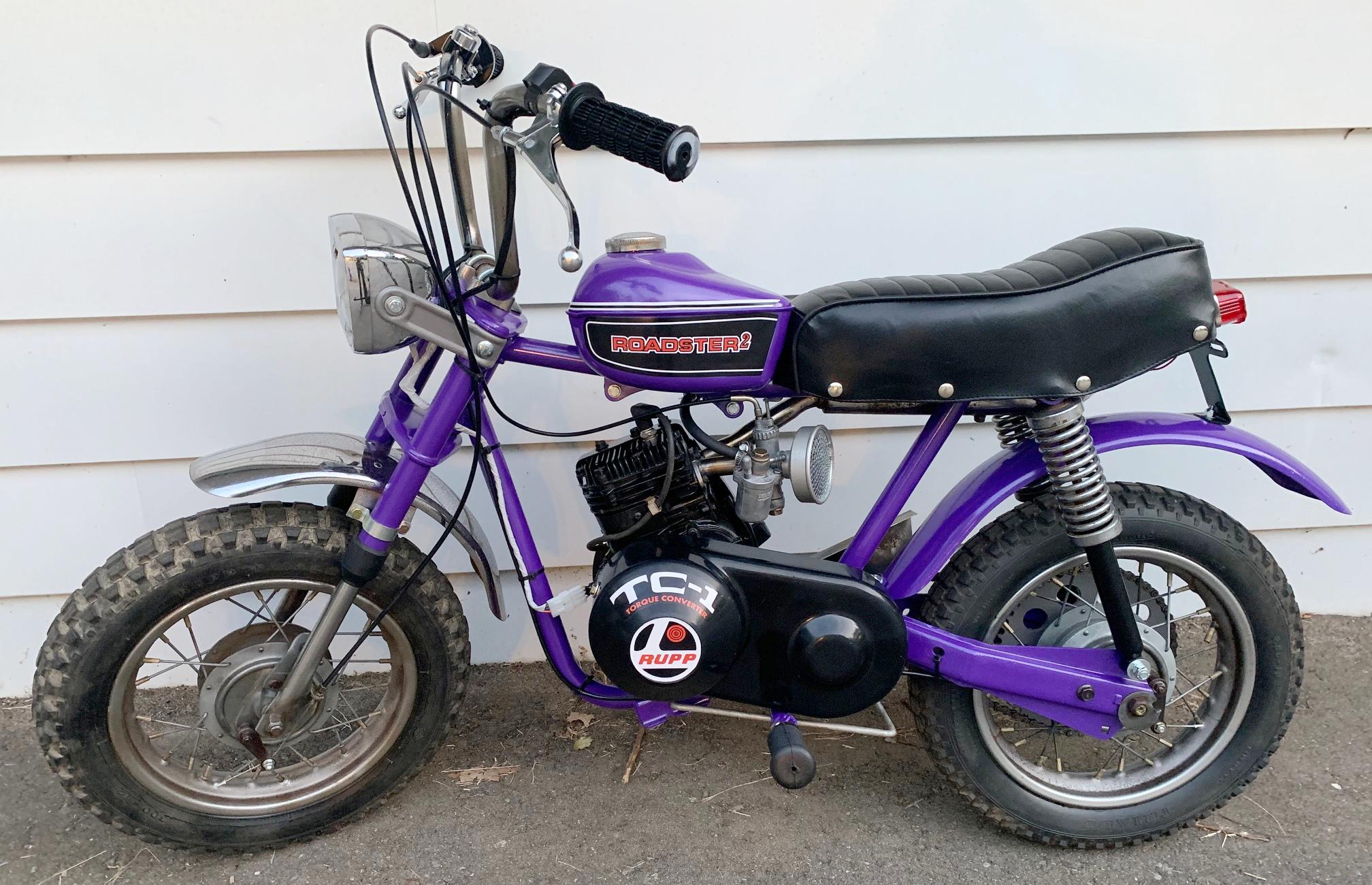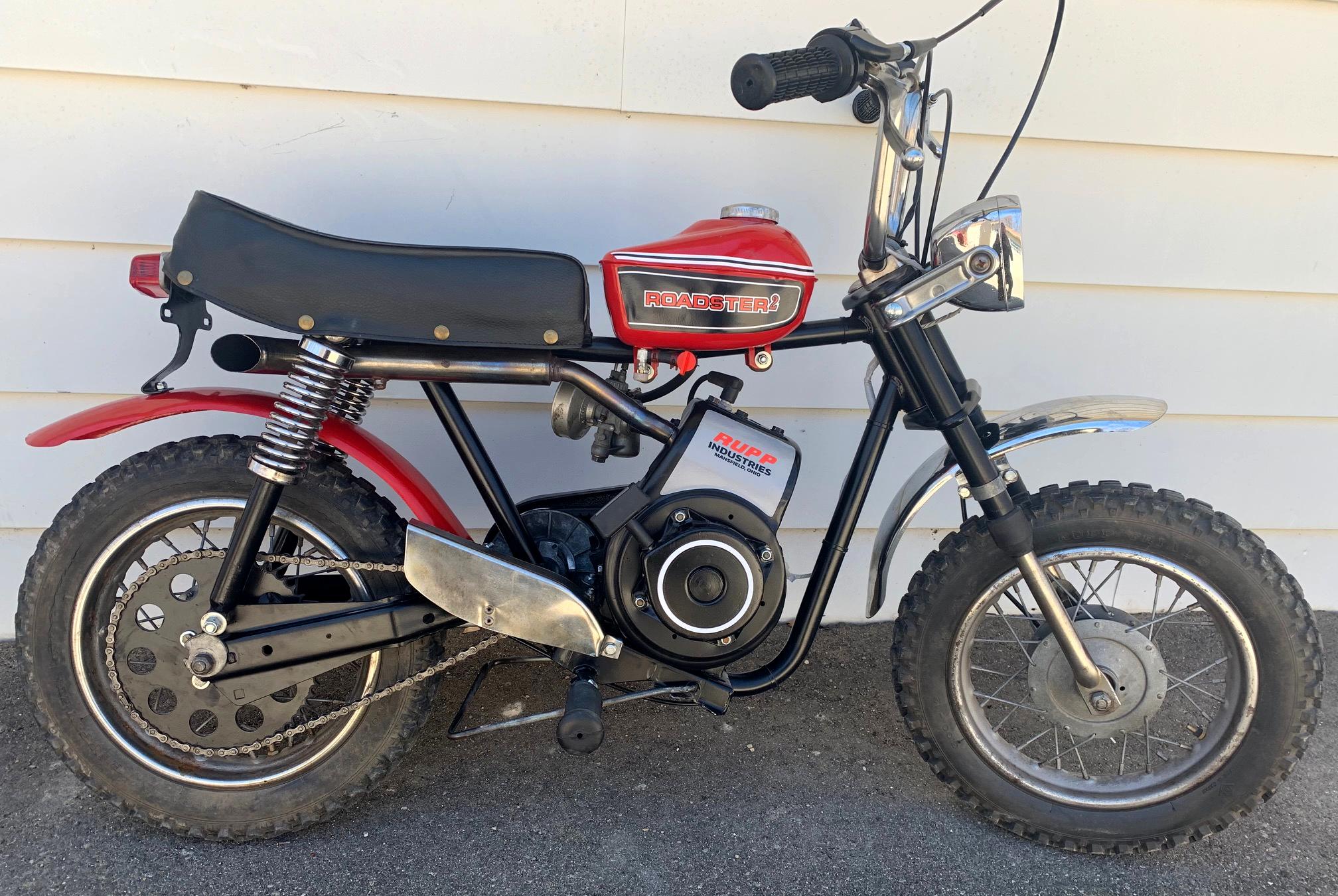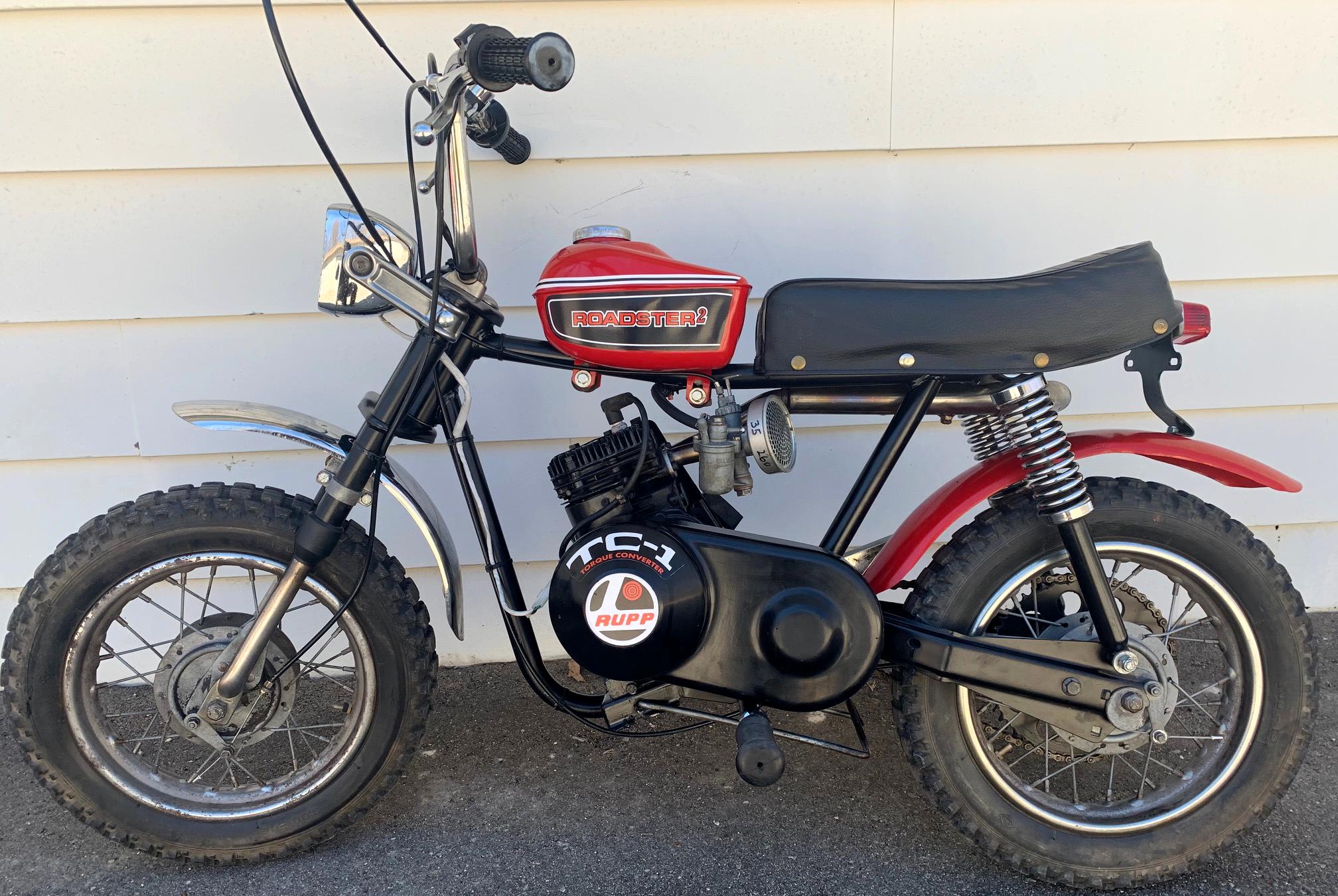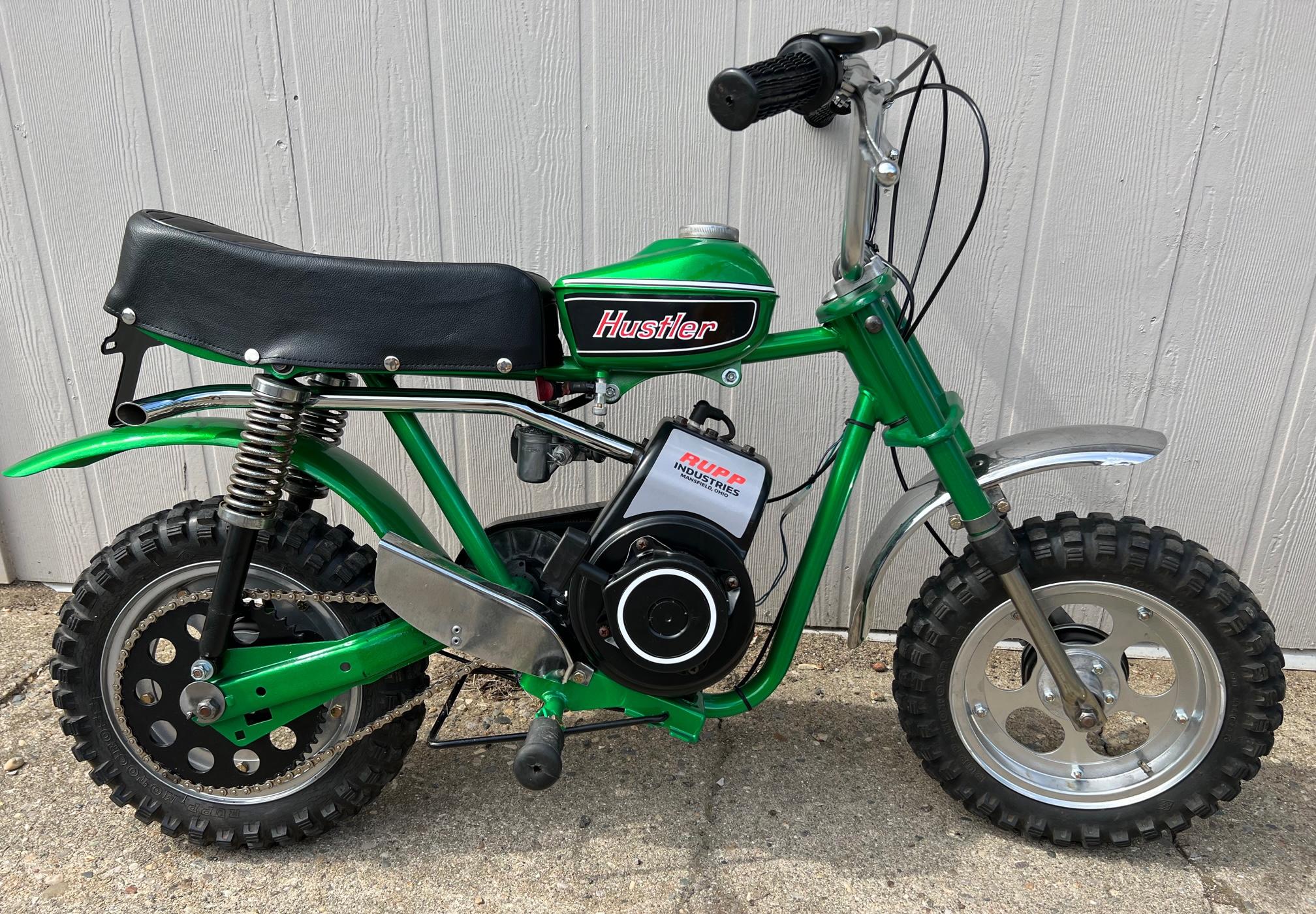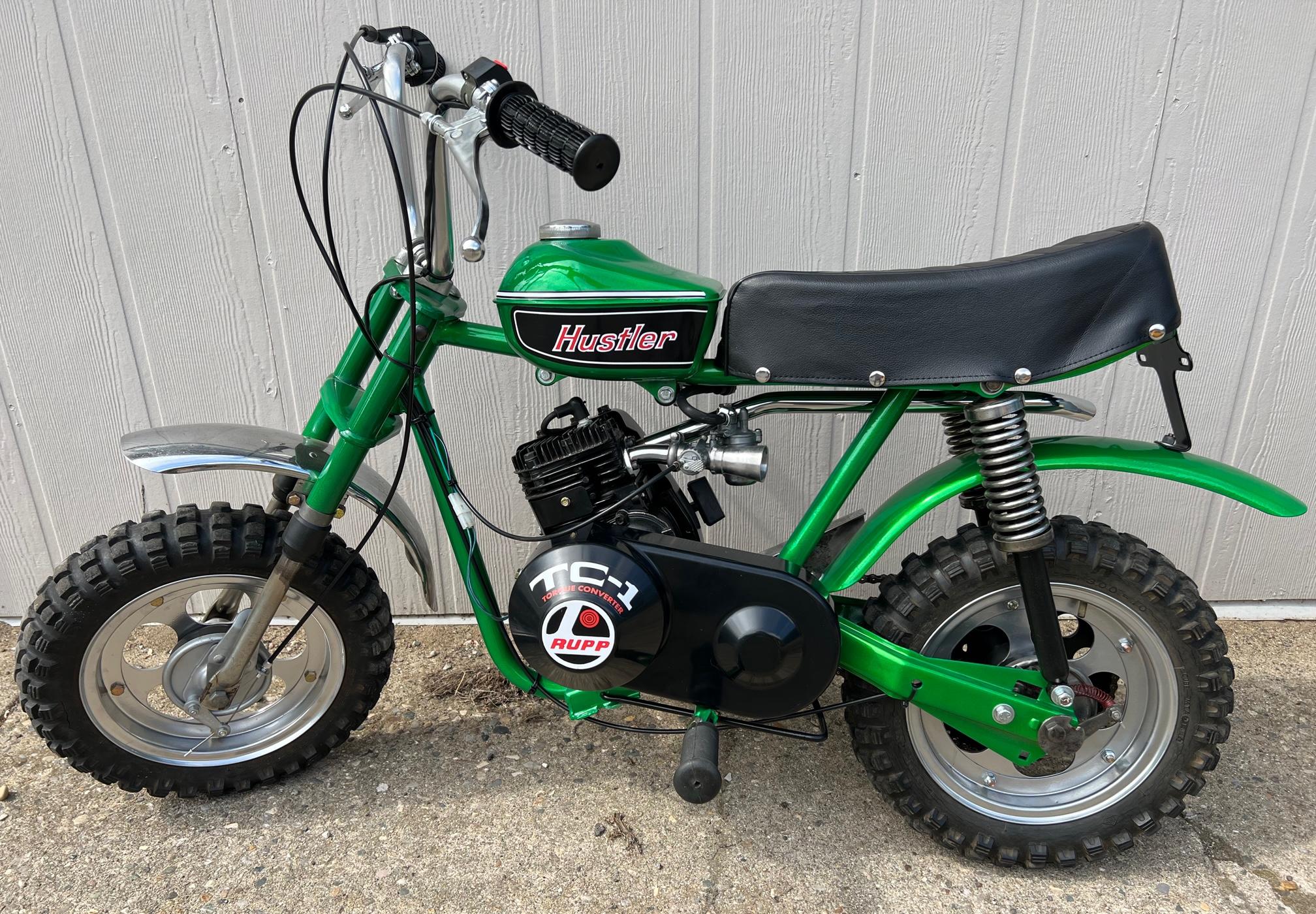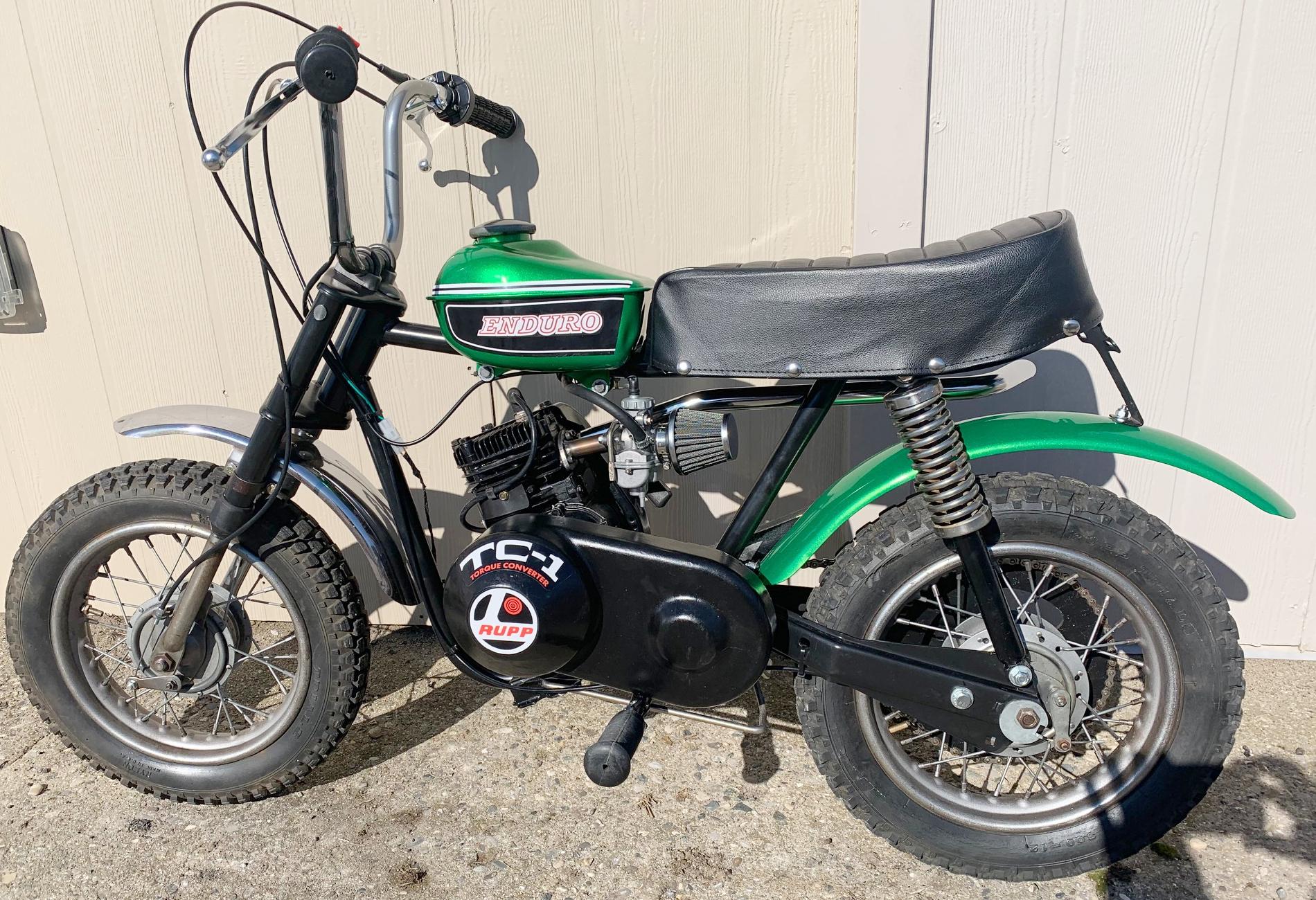I buy and collect Rupp minibikes. 5/01/24. Email: cfh@provide.net
Overall Rupp History.
Rupp Manufacturing, Inc. was founded in 1959 by Mickey Rupp, with eight employees in a 3,000 sqft facility in Mansfield, OH. During that first year, Rupp manufactured Dart Karts (no mini bikes until 1962.)
In 1960 Rupp expanded their production to making mini-bikes. Rupp made 1,000 mini-bikes that first year. By 1964 Rupp created a few snowmobile prototypes and in 1965, became a snowmobile manufacturer making 500 machines.
In 1963 and 1964, Rupp supplied go karts and minibikes to Sears, and were sold through the Sears catalog. The 1963 style Rupp Dart Cycle mini bike was sold up to 1964 in the Sears catalog as the "Sears Cylce".
By 1969 Rupp employed over 400 people in a 180,000 sqft facility, producing a multitude of recreational machines including mini-bikes, ATVs and go-karts, and five models of Sno-Sport snowmobiles.
In 1970 Rupp sales topped $30 million and owner Mickey Rupp was honored as one of the "Outstanding Young Men of America." Rupp produced 35,000 snowmobiles that year.
By 1971 Rupp employed 850 people, and featured a research center, administration building, all-purpose proving grounds, a styling building, and even had some automatic computerized operations. In addition, owner Mickey Rupp served as a director of the International Snowmobile Industry Association. But by 1972, fueled by a soft market created by a couple of years of poor snow conditions, Rupp's profits dwindled and the company began to lose money.
In 1973 Mickey Rupp was forced to sell the company which was facing bankruptcy. On April 1st, 1973, Rupp sold a controlling interest in the company to an investment group led by Joseph Hrudka. 1973 would also mark the end of the Rupp partnership with the Japanese engine manufacturer Tohatsu. Then in 1974, Rupp would make the design change to using Kohler powerplants in their snowmobiles.
In 1974 and 1975, Rupp saw a decline in overall sales. This was likely due to rumors of the company going out of business, nagging quality control issues, and the transition period under new ownership of Hrudka from the extremely popular and company founder, Mickey Rupp.
In 1976, Rupp seemed to be poised to make a major comeback with the introduction of snowmobiles with liquid cooled Xenoah powerplants. The 1976 liquid cooled Nitro model was tested by SnowSports magazine and "was the top performer or close to it in every speed run." Despite the popularity of the new models, Rupp continued to experience financial difficulty.
By the Spring of 1977, the ownership of Rupp filed for bankruptcy and enlisted help from Arctic Cat. As a result of this partnership with Arctic Cat, snowmobile production was cut in half and down to just three models - a 295cc fan cooled Sport, and two liquid cooled Nitro models. Although Rupp designed, engineered, and marketed their 1977 line-up, the Rupps were actually produced and assembled by Arctic Cat. The 1977 Rupp 440 Nitro was heralded as one of the fasted tested muscle sleds by snowmobile magazines and featured an 80HP motor capable of attaining speeds in excess of 80MPH. But by the Summer of 1977, the writing was on the wall and the 1978 model year would be the last for Rupp. Rupp Manufacturing, Inc. would go under in 1978, never to resurface again.
See how a 1972 Speedway Red Baron mini bike is restored from junk bin in the NINE part video series on YouTube! A lot of this information applies to Rupp mini bikes too.
-
In 1970 Rupp serial numbers started with a "C" on a foil tag underneath
the seat on the seat pan. In 1971 the serial number was still on the seat pan, still on a foil sticker.
But the first serial digit is a "1". For 1971 models, the "C" serial number is actually
left over production from 1970, but on early 1971 models.
The first number/year format continued into 1972-1976.
But what did not continue was the second digit information as the model.
No one knows why for sure, but I suspect it was just too much trouble,
or there was no real reason to code the actual bike model into the serial number.
This may had something to do with the change in 1972 to a standard black
colored frame (which would work for a number of models.)
- 1 = Bandit
- 2 = Black Widow or Swinger Trail (both black frames).
Note BW is generally in the "1 200001" to "1 204000" serial number range like say "1 201851". Best guess on production estimates is about 4000 Black Widows. Lowest and highest ranges seen are "1 200520" and "1 203661". Note on the Swinger, there is no small space between the "1" and the rest of the numbers (there is a small space with a Black Widow.) - 3 = Enduro
- 4 = Hustler
- 5 = Rascal
- 6 = Roadster2
- 7 = Scrambler
For 1971 only, after the "1", the second digit of the serial number was:
Middle: 1971 Rupp serial number for a Roadster2.
Bottom: 1972 Rupp serial number, model unknown.
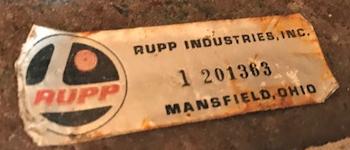

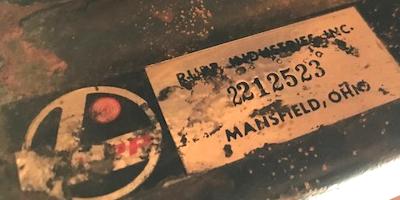
Top: 1971 Rupp Swinger Trail (JC Penney) serial number. It is in the Black Widow
serial number range, but the frame differences give it away. Also there's no
space between the first and second digit. A small detail but it means a lot.
Middle: 1970 Rupp "C" serial number, model unknown.
Bottom: 1970 Rupp "C" serial number on a January 1971 Black Widow.

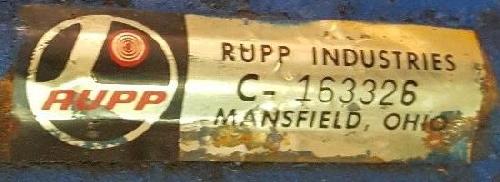
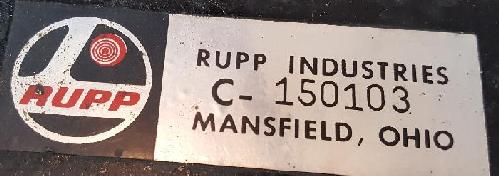
Rupp Mini Bike History and Information.
-
1962 brought the very first Rupp mini bike was the Dart Cycle. The bikes came with
front suspension and rear drum brakes and 5" wheels two piece wheels with grease ports and Good Year tires.
There was also a jackshaft.
Used a 2.5 HP 4-cycle Lauson engine with a Fairbanks-Morse clutch,
and only $199. This model continued into 1963, but changed a bit, and was called the
Rupp Dart Cycle Deluxe. It now had 6" wheels and a 3.5hp motor was an option.
There was an ID tag on the frame stating the model. Though Rupp's line stopped
selling the Dart in late 1963, the Rupp Dart Cycle was still available from
Sears via their catalog! It was known as the "Sears Cycle".
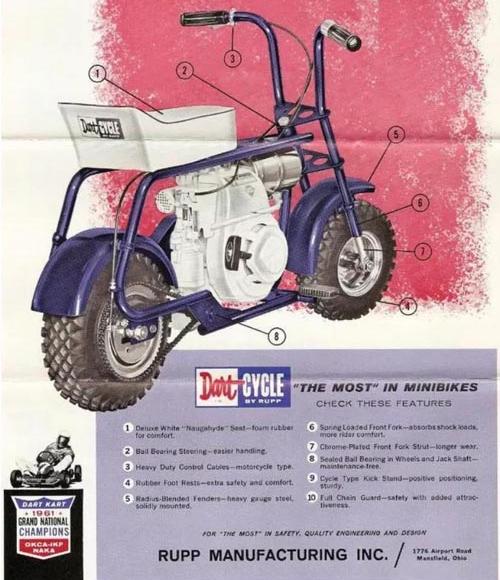
1963 Rupp Dart Cycle Deluxe minibike.
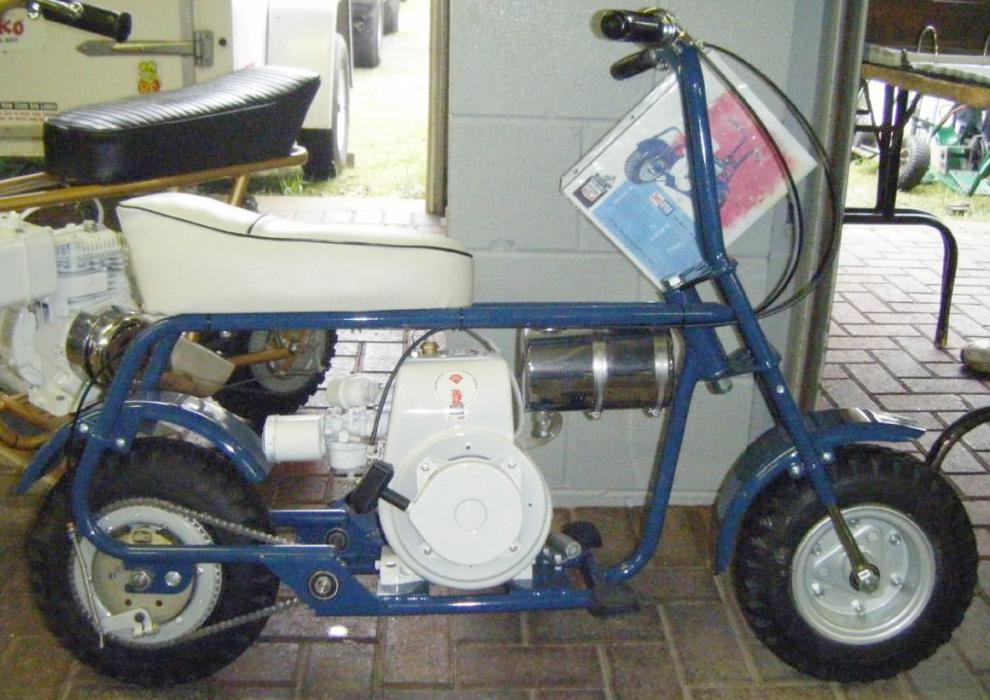
1964 Sears catalog selling the Rupp Dart Cycle minibike as the "Sears Cycle".
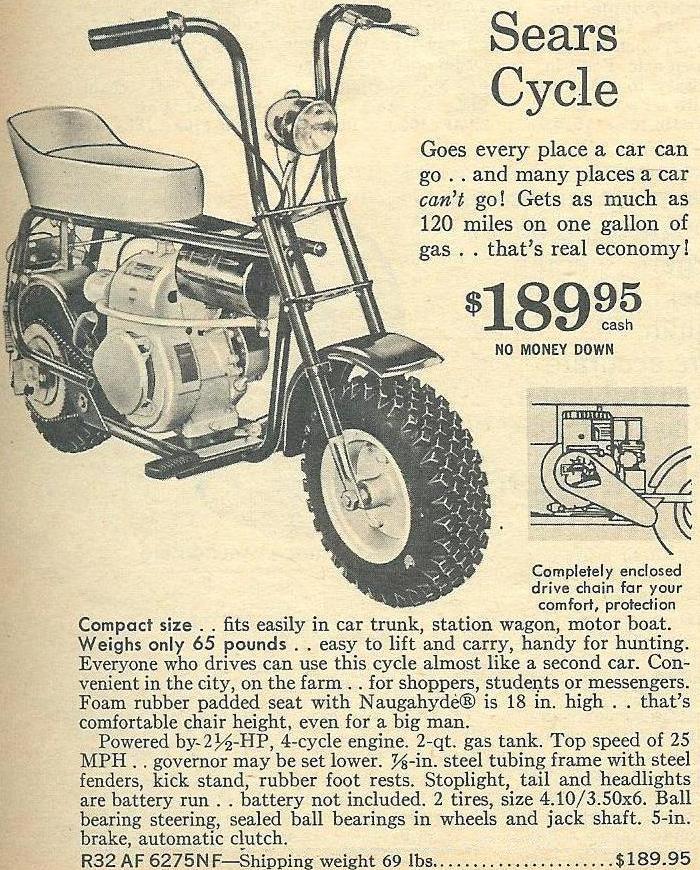
-
In 1963 Rupp made the Dart Ridge Runner (AKA trail scooter). Had a 3 1/2 HP Lauson engine
with a belt drive system and dual fuel tanks.
A passenger seat was located over the two fuel tanks.
It came in one color: high-visibility orange.
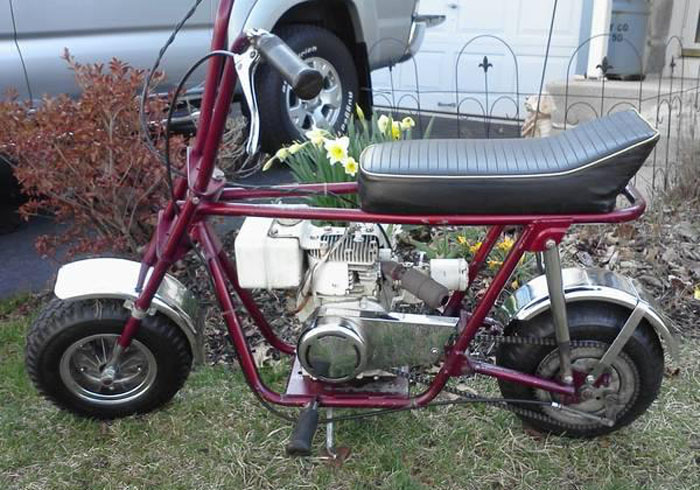
-
Then in 1964 to 1967 the Rupp Minibike lineup consisted of the "Continentals", which replaced the Dart line.
The models included the Continental Custom (full suspension and a H35 engine at 3.5hp),
the Continental Special (hardtail with no rear suspension but had front suspension and H25 engine at 2.5hp)
and the Econo-Cycle (H25 engine at 2.5hp and side gas tank, also available in kit form.)
Lighting for these models was also available as an option. In 1965 the wheels became mags aka Grand Prix mags.
Check out the 1967 Rupp mini bike catalog for pictures.
All models used Lauson engines and all had 6" wheels.
For the first time in 1964 Rupp also outfitted the bikes with a head and tail light.
A chrome chain guard and chrome fenders were added features of the Continental.
The Continentals had many models of their own, including the Electra, Custom,
Special and Cub. Late 1965 used the Tecumseh 3 1/2 HP on the Continentals as well.
- Continental Electra: 3.5hp Lauson engine, front and rear suspension, front and rear lights, red, gold or blue
- Continental Custom: 3.5hp Lauson engine, front and rear suspension, red, gold or blue
- Continental Special: 2.5hp Lauson engine, front suspension, red.
- Continental Cub: 2.5hp Lauson engine, no suspension, gold.
- D-300: go kart with Tecumseh H25 2.5hp engine, live axle.
- Dart Concession Kart: Tecumseh H35 3.5hp engine.
- Chevy Jr: Tecumseh H35 engine, scaled down version of a Chevy SS car, fiberglass body, blue with white stripes.
- Fun Kart: 2.5hp Lauson engine,
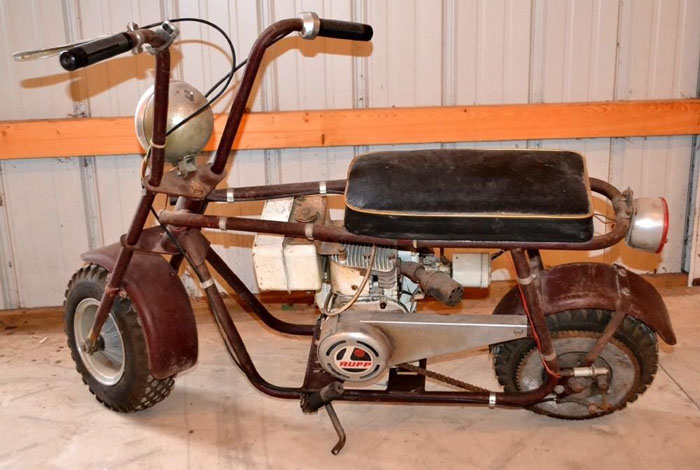
-
In 1968 the introduction of the "eye candy" mini bikes from Rupp.
Check out the 1968 Rupp mini bike catalog for pictures.
Models included: TT-500, XL-500, XL-350, C-500, C-350, C-250, Cub.
Three colors available: metallic blue, metallic red, metallic gold.
All bikes had 6" turbine wheels. The model number of the bike generally noted
the horsepower of the engine ("500" meaning 5hp, "350" meaning 3.5hp, etc.)
Tecumseh was now the engine solely used by Rupp.
Also cable operated disc brakes (1968 was the only year of disc brakes on a Rupp).
Models were designated with a "C" followed by a number based on the engine size. Three models of Continentals were offered in 1968 including the C-350, C-250 and C-220 Cub. The C-220, or Cub, was an economy model which featured a different (not chrome) chain guard, as well as a scrub type brake, smaller seat, and different fuel tank. The Cub could be purchased not assembled as a kit at a discount.
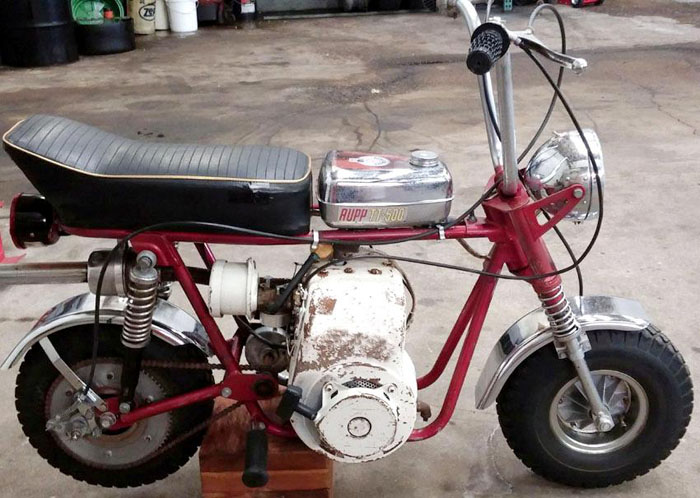
-
Higher models were the XL-350, XL-500 and TT-500. All of these newer models featured front and
rear disc brakes, headlight/taillights, chrome chain guards and automatic clutches with
jackshaft. Also new to these bikes were external spring shocks, front and rear, and
noncontinuous forks and handlebars. The TT-500 was the top of the line newer model and
featured a different chain guard as well as a two speed jackshaft. The XL-350 and XL-500
were identical, both featuring a single speed jackshaft, with the exception of the engine
size (3 1/2 and 5 HP, respectively.) The motor plate on the 1968 frames was one piece.
1968 marked the last year Rupp would make the Continental series of mini bikes.
- TT-500: Tecumseh H50 engine, 2 speed, lights front & rear, jackshaft.
- XL-500: Tecumseh H50 engine, lights front & rear, jackshaft.
- XL-350: Tecumseh H35 engine, lights front & rear, jackshaft.
- C-350: Tecumseh H35 engine, front and rear suspension, blue.
- C-250: Tecumseh H25 engine, front suspension only, red.
- C-220 Cub: Tecumseh H25 engine, no suspension, gold. (available in kit form too.)
- Chevy Jr: Tecumseh H35 engine, scaled down version of a Chevy SS car, fiberglass body, blue with white stripes.
- D-300: Go kart with Tecumseh H25 engine, live axle.
- Fun Kart: Tecumseh H25 engine.
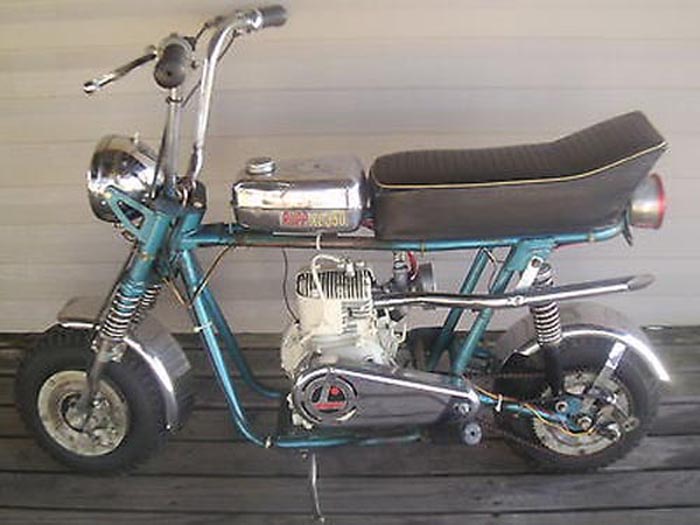
-
Since 1968 was the start of Rupp only using Tecumseh engines (though technically
a "Lausons" engine is a Tecumseh), we should probably talk about Tecumseh engines.
In 1956 Tecumseh bought Lauson engines. They pretty much immediately started to
get rid of the Lauson design, and change it over to Tecumseh. But they
still used the "Lauson" name on a lot of models up to about 1967. At
this point they dumped the Lauson name, and all models became "Tecumseh",
and the Lauson moniker disappeared. Just keep that in mind...
The smaller H25/H30/H35 (2.5hp/3hp/3.5hp) Tecumseh motors were
all "small frame" motors. The "H" means horizontal shaft, and usually there's
an "S" after the "H" to show it's a small frame "HS" model. But the H25/H30/H35 did
not do this. In 1968 Tecumseh introduced the small frame HS40 motor 4hp (note the "S"
in this new model.) Though Rupp didn't start using this motor until 1970, it
became the Rupp gold standard engine throughout the 1970s. And in 1972 the
Tecumseh HS50 motor (small frame) was introduced, but this was not used on any
of the "traditional" Rupp minibikes (Roadsters, etc).
- Tecumseh H50 65151h - 1969 Roadster (with lighting coil)
- Tecumseh H35 45303g - 1970 Sprint, gray
- Tecumseh H35 45304g - 1970 Scrambler, gray
- Tecumseh HS40 55295c - 1970 Fox, gray, diaphragm carb (non-angled intake)
- Tecumseh HS40 55282b - 1970 Roadster lighted version, gray, diaphragm carb (non-angled intake)
- Tecumseh HS40 55330c - 1971 Black Widow, Dellorto carb, long governor arm removed (first motor revision used on BW.)
- Tecumseh HS40 55331c - 1970 Roadster lighted version, gray, diaphragm carb (non-angled intake)
- Tecumseh HS40 55355c - 1971 Hustler, with angled intake. Also this engine number seen on Black Widows with Dellorto carb and long governor arm removed (second motor revision used on BW.)
- Tecumseh HS40 55356c - 1971 Roadster2 lighted version, black, with angled intake
- Tecumseh HS40 55388c - 1972 Roadster lighted version (date code #1337c, #2032b, #2070c)
- Tecumseh HS40 55286b - 1970 Speedway Scarab (date code 0232) white engine with lighting coil.
- Tecumseh H50 65151H - 1968/1969 white engine with a lighting coil used on 1969 Rupp Roadsters and 1968 Rupp TT/XL500 models.
That all said, the 1968 and 1969 Rupp models with Tecumseh 5hp motors used the extremely wide body H50 motor with a balloon logo. If you have ever seen one of these monsters, it's a *wide* motor. When Rupp went to the more streamline style spoke wheel bikes in 1970, the H50 motor was not going to work (it's just too big to fit in that frame format.) Hence Rupp's change to the small frame Tecumseh HS40 motor as their "gold standard" motor on their popular bikes (spoked wheel Roadster, etc.) The Tecumseh HS40 had model numbers on the blower housing. Here's some examples of Tecumseh HS40 motor model numbers used by Rupp (and some others) that I seen on original bikes:
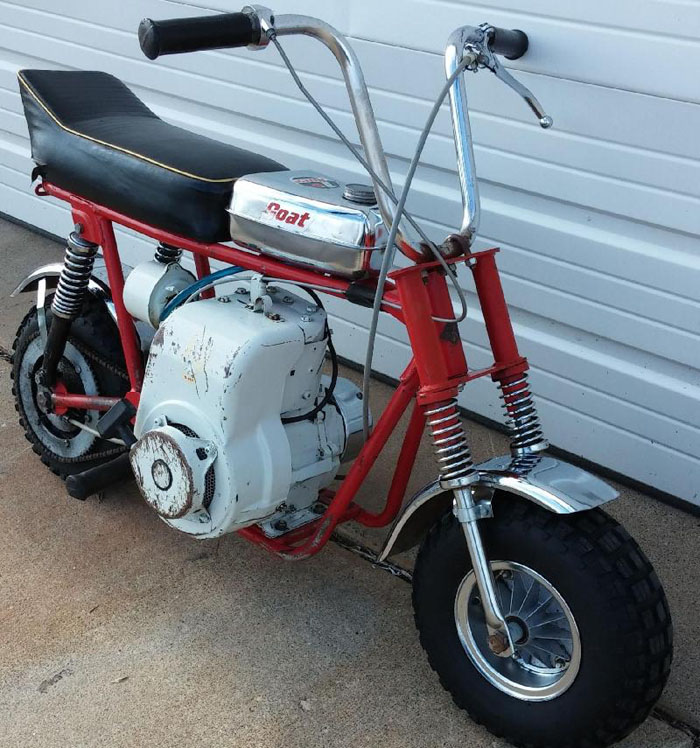
-
The 1969 model names changed from the 1968 lineup.
Check out the 1969 Rupp mini bike catalog for pictures.
The models included Roadster, Goat, Scrambler and lower models Digger, Sprint, Banchi, Chopper.
All had 6" turbine wheels and Tecumseh engines.
Roadster & Scrambler had rectangular headlight (new for 1969) and tail/brake lights.
The power switch for the lights was mounted right on the top of the light
(and there was just a single beam, no lo/hi beam.)
Full exhaust pipes were now the norm along with drum brakes.
Motor plate was now two pieces (prior years were a single large motor plate.)
The underside of the fuel tank will tell you if it is a 1968 or 1969 Rupp tank.
The 1969 Rupp gas tanks look just like the 1968 models, except for the underside.
(A 1969 Rupp gas tank has three round disks with nuts for mountingm where the
prior 1968 Rupp tank has a triangular plate with studs welded to it for mounting.)
Five colors available: Blue metallic, green metallic, red, yellow, orange.
Again the 5hp motors were all the wide body Tecumseh H50 motor with a balloon logo.
- Roadster: Two speed jackshaft and Tecumseh H50 (5hp) engine. Rectangle headlight and rear bake/tail lights.
- Goat (aka Ram): 2 speed jackshaft and Tecumseh H50 (5hp) engine, no lights.
- Scramber: Tecumseh H35 3.5hp engine with lights (like the Roadster), single speed jack shaft
- Digger: Tecumseh H50 5hp engine, no lights, only came in blue metallic
- Sprint: Tecumseh H35 3.5hp engine, no lights, only came in green metallic
- Banchi: Tecumseh H25 2.5hp engine, no lights, no rear suspension, only came in yellow
- Chopper: Tecumseh H25 2.5hp engine, entry level bike, no bells or whistles, only came in orange
There is a rumor that General Motors and/or Bonham Tote Gote threatened a lawsuit against Rupp if they didn't stop using the name "Goat" for a mini bike (apparently GM trademarked "Goat" as a name for their GTO car.) So Rupp changed the "Goat" model to the "Ram". That's the rumor at least.
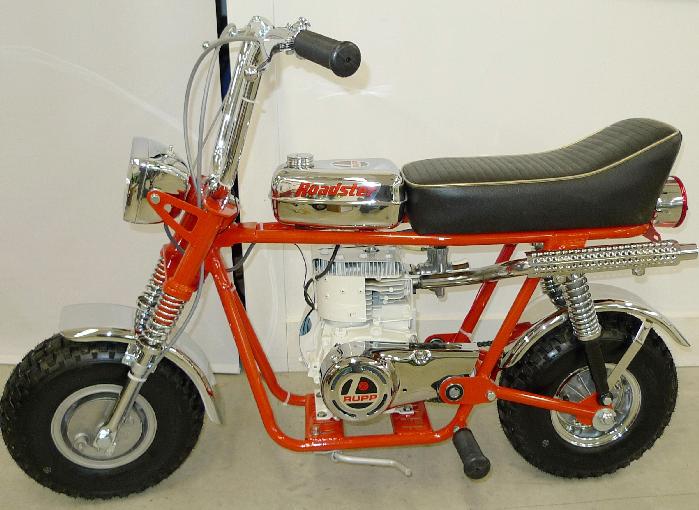
1969 Rupp Roadster mini bike restored with "bang bars" added and optional chrome exhaust.
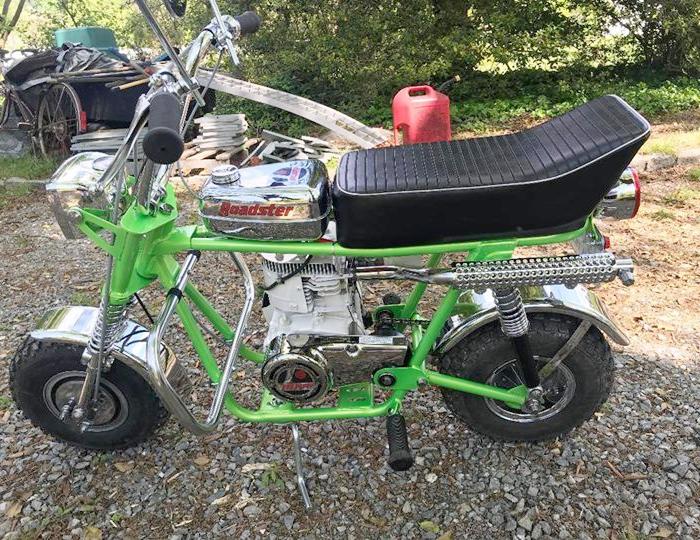
-
1970 was a big year for Rupp.
Check out the 1970 Rupp mini bike catalog for pictures.
Entirely all models redesigned from top to bottom.
Redesigned motorcycle type minibike frame, angled 20 degree mounted engine,
Torque convertor drive (known as the TC-1),
and 10" spoke rims (Roadster, Enduro, Scrambler only). This is the ONLY year Rupp
used a 10" spoked wheel rims. (Note no US manufacturer had 10" rims, so they were imported from
Italy and outfitted with US made tires. Mostly used 3/16" individual ball bearings.)
The Italian rims were mostly made by Sanremo (most of the 12" rims also made by them.)
Center style kickstand now used. Rupp used a slanted 20 degree engine plate with a diaphragm carburetor
(the diaphragm carb does not have a float bowl, so the 20 degree angle doesn't hurt performance.)
The 10" models included: Roadster, Enduro, Scrambler and these had the TC1
torque converter with a Comet TC88 style 200421a torque converter belt 5/8" wide
(also Rupp #15162).
The lower-end 6" turbine wheel models included: Sprint, Chopper.
Available colors: metallic blue, red and orange.
All engines and gas tanks were silver metallic with balloon Tecumseh logos.
The wide Tecumseh H50 motor was abandoned and replaced with the smaller frame Tecumseh HS40 motor
(which was actually introduced in 1968, but was not really used on Rupp bikes until 1970.)
All but Chopper had headlight brackets. Number plate was used in place
of headlight on Enduro, Scrambler, and Sprint models. Angled engines used
a diaphram carb (no float bowl.) Bikes with a headlight (retangle) now had the light switch
on the handlebars, with a lo/hi beam switch. On the back of the seat, the word
"RUPP" was silkscreened in tall bold letters.
- Roadster: lights front & rear, TC-1, Tecumseh HS40 4hp engine with lighting coil, 10" spoke rims. Exterior front fork springs.
- Enduro: New model for 1970. Number plate (no lights), TC-1, Tecumseh HS40 4hp engine, 10" spoke rims
- Scrambler: number plate (no lights), Tecumseh H35 3.5hp engine, 10" spoke wheels, no front brake
- Sprint: number plate, Tecumseh H35 3.5hp engine, No TC-1 (standard clutch), 6" wheels/tires
- Chopper: Tecumseh H25 2.5hp engine, entry level bike, no bells or whistles. No suspension, scrub brake.

-
In 1971 brought more changes and refinements to the minibike lineup.
Check out the 1971 Rupp mini bike catalog for pictures.
The introduction of the famed & fast Blackwidow.
New telescopic front suspension.
Roadster2 and Enduro available in red, green metallic, blue metallic. Interior front fork springs
now used (instead of exterior front fork springs).
Purple metallic offered only on the Roadster2 in 1971.
New 12" spoke wheels on three models (Roadster2, Enduro, Black Widow),
new 10" slotted mag wheels on two models (Hustler, Scrambler).
On the 12" wheels, the catalog stated 36 spokes were used. In reality
they used 24 or 28 spokes (whatever they could get.) There was no
rhyme or reason as to what bikes got either 24 or 28 spoke wheels
(be it Roadster or Black Widow or Enduro.)
The frame changed slightly from the 1970 models - the engine mounting point
moved back about 1/2 inch. This required a different torque converter belt.
The 1971-1975 models that used the TC-1 torque converter now use a Rupp 17617 or
Gates 6061 belt or Dayco GTS407 or Goodyear 70003 belt (a Comet 88 series #200419 belt does not work.)
This change also required a shorter TC1 cover too.
About March 1971 Rupp changed from a diaphram carb on the angle mounted motors to a
standard Tecumseh float bowl carb (but with a custom intake manifold so that
the carb was level on an angled motor.) With this change
the motor color changed from silver to black - well not exactly. The motor color
change happened with the model year change, so some black Tecumseh HS40 motors
with a diaphram carb were used until March 1971. At that point the black HS40 engines
now had a slant intake manifold with a float bowl carb.
On the back of the seat, the word
"RUPP" was silkscreened in tall bold letters, but was also seen in small petite letters (either
style is correct.)
- Blackwidow: Tecumseh HS40 4hp engine, Dell'Oroto ua19s carb, TC-1, straight pipe exhaust, 12" spoke rims, "Rupp Motocross" tires, 24 or 28 spoke rims were used. Bike color was black only. Dellorto carb and disabled governor on the black Tecumseh hs40 engine. Note the Black Widow came with a black rear fender. BUT Rupp also sold, as an option, a chrome rear fender. So sometimes you see Black Widows with chrome front and rear fender. It is estimated that Rupp made about 4000 Black Widow minibikes. Note the engine on the Black Widow is the same engine as a Hustler or Enduro, but with some external modifications (usually a Tecumseh 55355c or 55330c.) For example, the governor arm is usually removed, and the governor spring tagged to the throttle assembly (so the internal governor assembly can't hit the cam.) The original throttle assembly is not used, as the Dellorto is a slide carb, and does not use this, but the assembly is still left on the engine. The original Tecumseh intake manifold and carb are of course gone, and replaced with a Dellorto intake and carb. The exhaust uses a bolt on short 1" manifold, which the 7/8" straight exhaust just slips over.
- Roadster2: Tecumseh HS40 4hp engine, lights front and rear, TC-1, 12" wheels 24 or 28 spoke rims, "Rupp Trials" tires.
- Enduro: Tecumseh HS40 4hp engine, no lights, TC-1, 12" wheels 24 or 28 spoke rims, motocross tires sometimes, but sometimes trials tires. Motocross tires specified in catalog, but you see about half of the Enduros made with trials tires.
- Swinger Trail: Sold by JC Penney under this name, basically a Roadster2 but with different hand grips and no Rupp engine decal or Rupp seat moniker. Black frame with a blue gas tank and rear fender. Gas tank and seat rear said "Swinger Trail", but no mention of Rupp.
- Hustler: Tecumseh HS40 4hp engine, TC-1, slotted 10" mag type rims, motocross tires, front and rear drum brakes.
- Scrambler: Tecumseh H35 3.5hp engine, slotted 10" mag wheels, trials tires, no front brake, green only.
- Bandit: Tecumseh H25 2.5hp engine, No TC-1, slotted 10" mag wheels, trials tires, no front brake, blue only.
- Rascal: Tecumseh H25 2.5hp engine, entry level bike, no bells or whistles, purple only.
The governor system on the Black Widow's Tecumseh HS40 engine. Because the Dellorto
slide carb did not use the standard Tecumseh throttle mech, the governor had to
be disabled. Tecumseh just removed the governor arm and the throttle linkages, and
used the governor spring to hold the governor mech. No internal changes where
made to the governor system
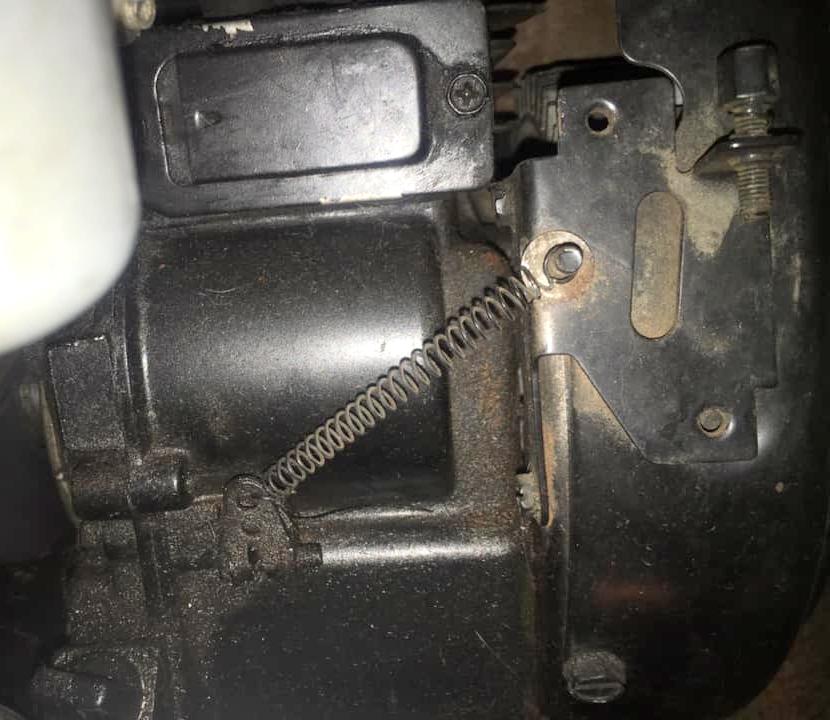
-
On the tires, they were made by IRC for Rupp, and had the "Rupp" name on the tires ("Rupp Trials" or
"Rupp Motocross", depending on the bike.) When Rupp went under around 1975, IRC continued to make
these tires, but they removed the "Rupp" name from the side walls (so they just said "Trials" or
"Motocross".) Note frames for 10" and 12" wheel bikes in the 1971-1975 era are the same.
But the swing arm is different: 10" wheel swing arm is 11.5" from
center pivot point to back tip, where 12" wheel swing arm is 12.5" long from center pivot point to back tip.
1971 Rupp engines used, as shown in their service letter.
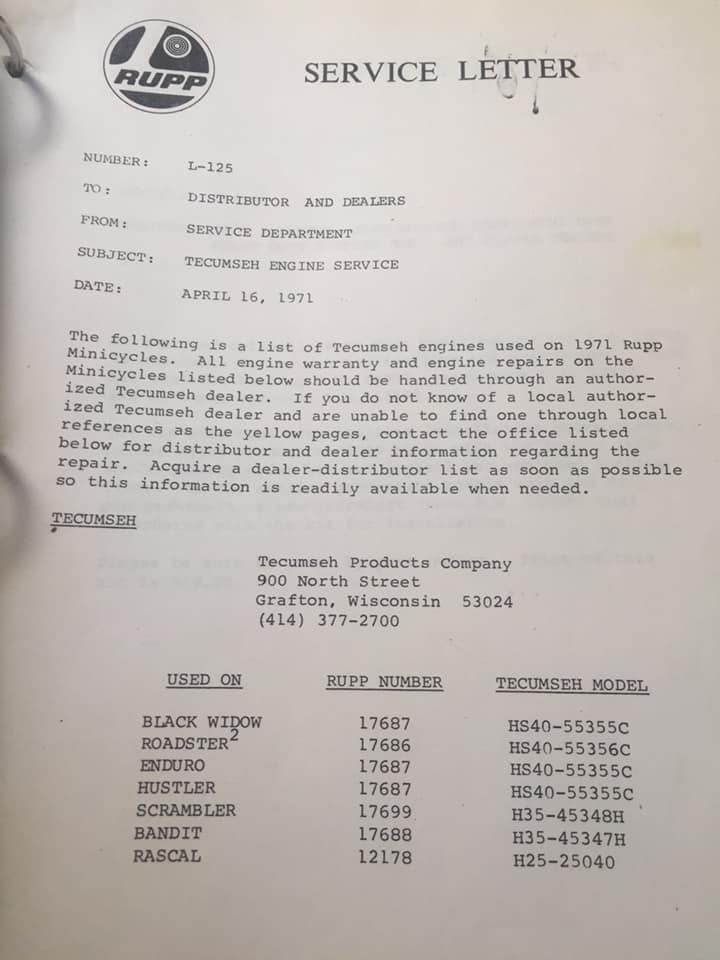
-
The 1971 Rupp service letter showed Tecumseh engine numbers used. Note the Enduro, Hustler and
Black Widow all had the same Tecumseh HS40-55355c engine. However Rupp modified the governor
assembly on the Black Widow engine, because the Rupp-added Dellorto UA19 carb could not use the governor
assembly. If you see the original Rupp governor modification, it looks like a hack, but that's how they did it.
1971-1973 JC Penney Swinger Trail, made by Rupp.
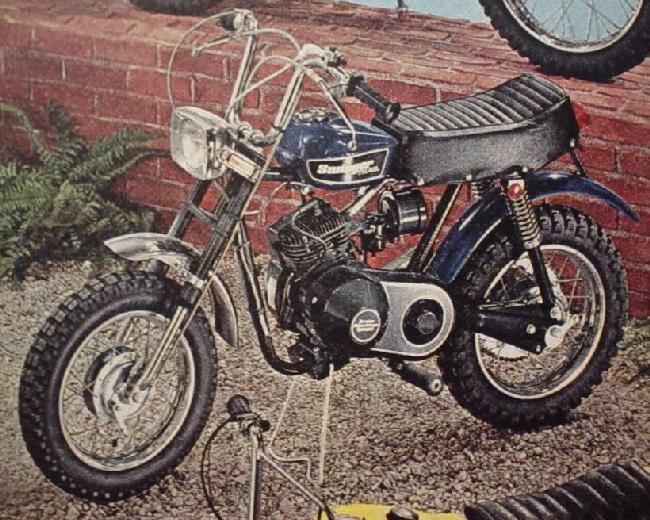
-
Another thing that happened in 1971 (and until 1973) was the introduction of the Swinger Trail,
made by Rupp and sold by JC Penney. This was basically a Roadster2. The gas tank and seat
back said "Swinger Trail" with no mention of Rupp. Also
the Swinger Trail came in different gas tank/rear fender colors (mainly blue), but always had a black frame.
The handlebar grips were different than Rupp's.
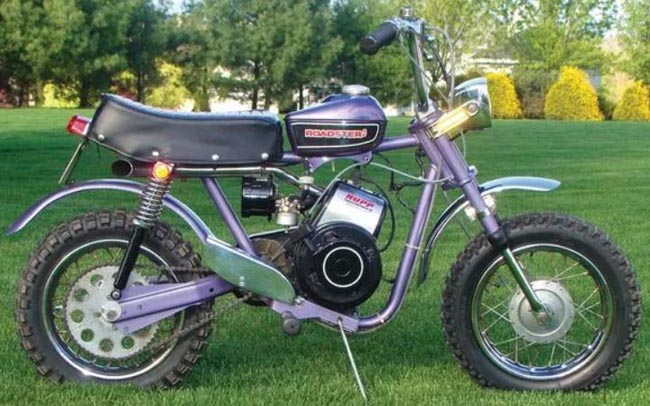
1971 Rupp Roadster2 mini bike in Green (only year for that color), 12 inch spoke wheels,
original HS40 motor. This is an early 1971 model with no slant intake and a diaphragm carb.
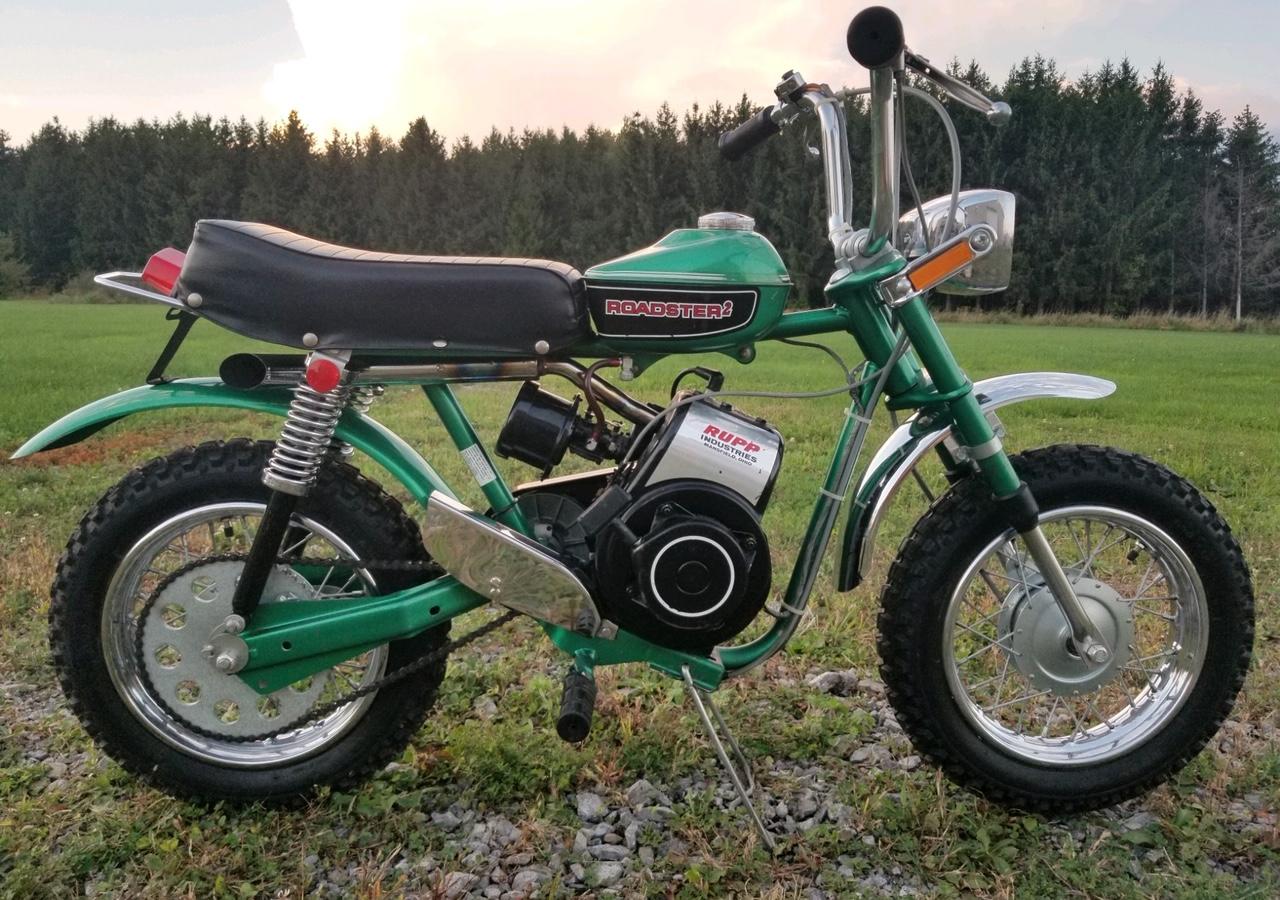
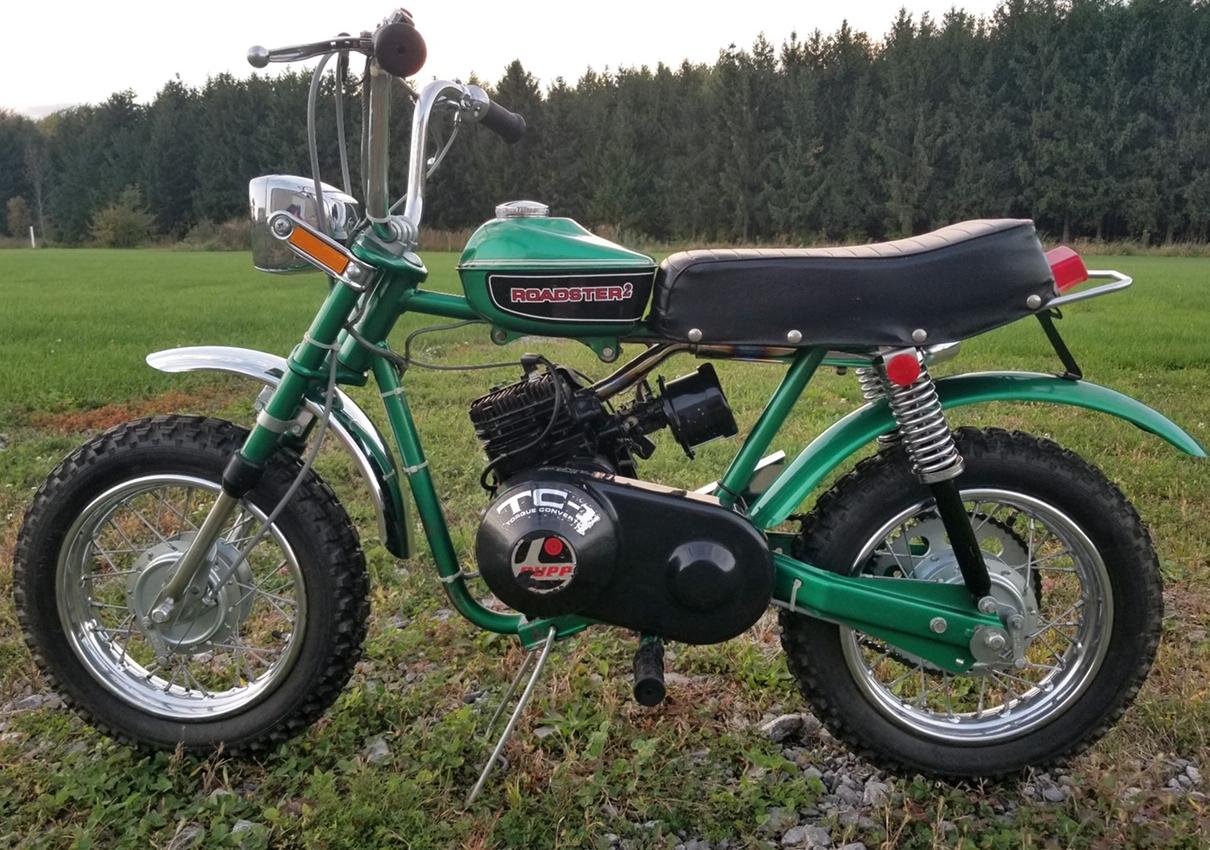
1971 Rupp Black Widow with the Dellorto ua19s carb and open exhaust.
Note that the Rupp Black Widow was only made in 1971. It was sold in 1972,
but that was left over stock from 1971. So all Black Widow serial numbers
should indicate 1971. The Rupp Black Widow was considered a racing bike.
Apparently the Tecumseh hs40 motor was "disposable", because the Dellorto
ua19s carb did not come with an air filter! In racing conditions how
long could that motor possibly last with no air cleaner?? This is a nice
bike though. The Dellorto ua19s (19mm) carb really does give a nice
performance boast.
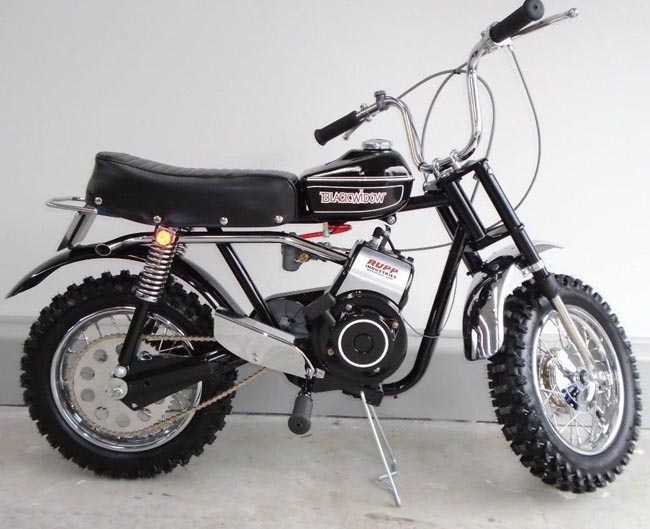
-
In 1972 the product line downsized a bit. Left over Blackwidows were being sold as 1972 models,
Roadster2, Hustler and Scrambler were all almost identical to the 1971 models.
NEED A 1972 RUPP CATALOG!
The big change was black frame (frame no longer painted the color of the gas tank, as in 1971).
Only the gas tank and the rear fender where painted a color other than black.
Also the swing arm and triple tree on all bikes were black (no longer the color
of the painted gas tank). The mechanics of the bikes were basically the same as 1971.
Enduro model was dropped during 1972. Hustler & Scrambler models only came in red. Roadster2 had one
new color available: Copper metallic. On the back of the seat, the word
"rupp" was silkscreened in short petite letters (though the prior used tall bold letters
can also be seen on 1972 models.)
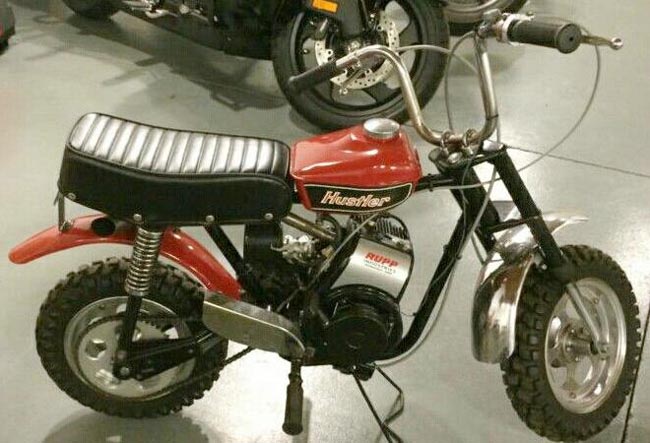
-
Then in 1973 to 1976 began a new era at Rupp with all models having Tecumseh engines
being dropped, except the newly re-designed Roadster2 and SS-5. The 1973 Roadster2 featured painted front fender,
no headlight reflectors and no rear shock reflectors. The decal package was all new.
Fenders now had stripes too. Available in brown metallic, with gold decals & brown seat,
or Magenta purple with silver decals and black seat. All had 4hp HS40 Tecumseh engines
with the new larger blower housing. Both Roadster2 models had lights front and rear.
The 12" wheels used 24 spokes only. The last year for the Roadster was 1976.
On the back of the seat, the word "rupp" was silkscreened in short petite letters.
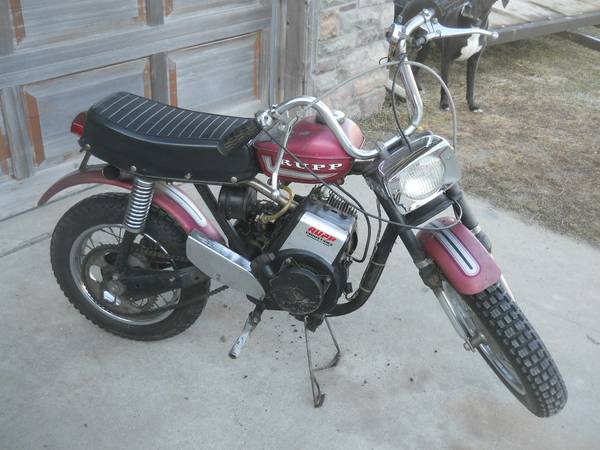
1974 Rupp Roadster in "poop brown". Not sure what they were thinking with
this color...
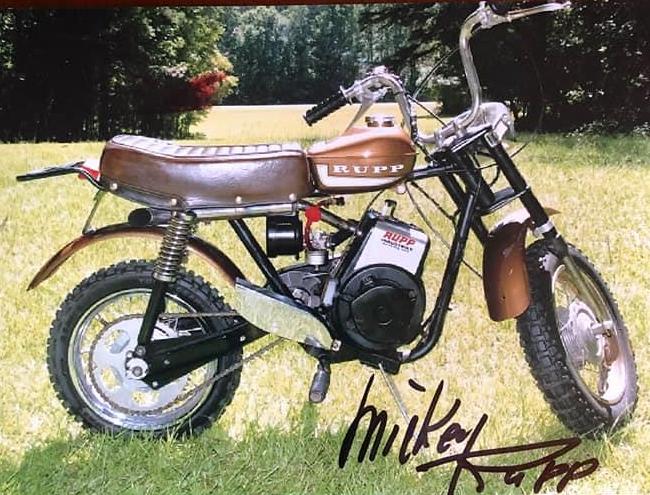
-
In 1972 Rupp's small motorcycles were the beginning of a new frontier for Rupp,
a small motorcycle, and the Rupp RMT-80 was born. Featuring a Fuji 80cc kick start engine
with a slide Mikuni carb,
manual 4 speed transmission, headlight w/hi-low, tail/brake light, horn,
true hydraulic suspension, 17" front and 16" rear wheels/tires. Built only in 1972,
the last bike to be designed by the master mind and original owner of Rupp Industries, Mickey Rupp.
This bike was street legal and rides quite nice. And it's a real minicycle with the
four speed manual transmission and two cycle engine. Though Rupp advertised it as
going 50mph, realistically it really only goes about 35mph. But the Fugi engine
has proved to be quite reliable over time.
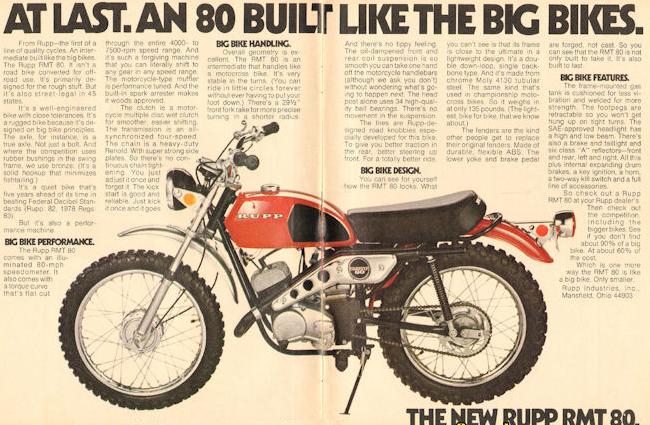
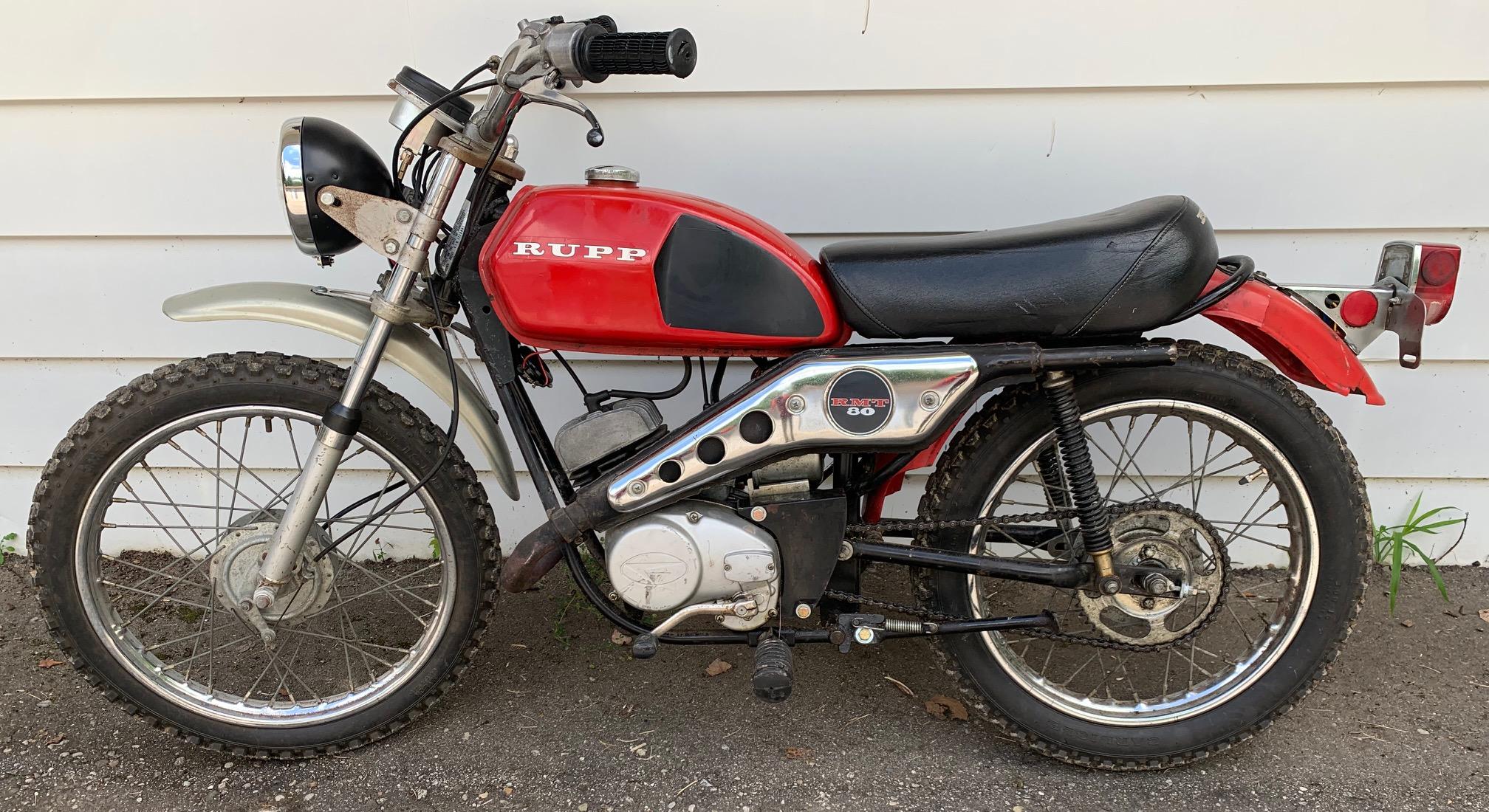

-
In 1973/1974, two more new models were introduced. The L-80 and L-100. The Rupp RMT-80 of 1972 was
redesigned and now called the L-80. The dual beam headlight, brake light,
speedometer were all deleted and replaced with a cheaper single beam headlight.
New larger type rear shocks, redesigned rear fender,
alloy front forks. The L-80 was painted in candy red, and the L-100 candy blue.
The L-100 had the same mechanics as the new L-80, but for a 100cc Fuji engine that
featured a 5 speed manual transmission. The L-100 with lights was
potentially street legal (where the L-80 was not.)
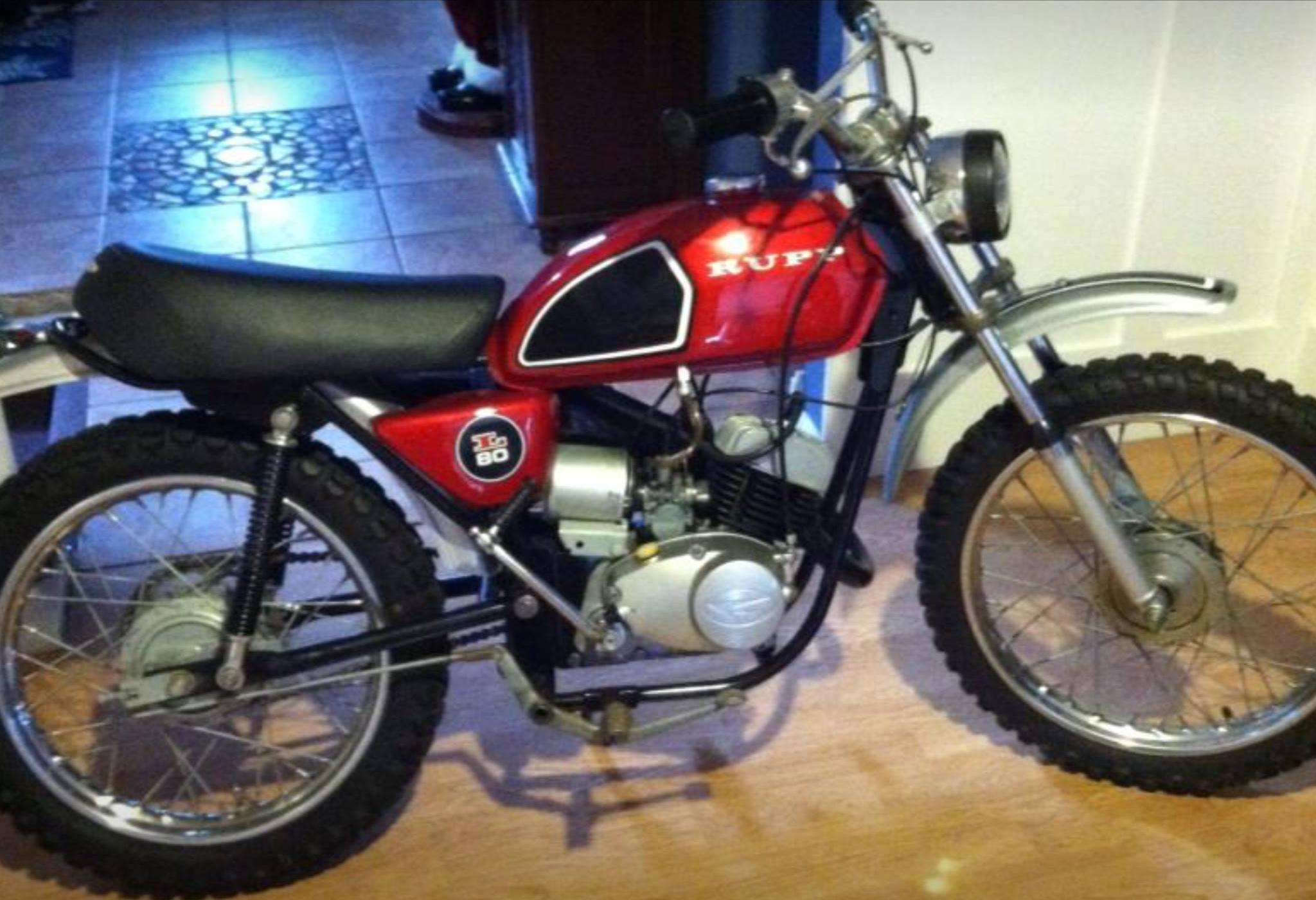
1973 Rupp L-100 mini-cycle.
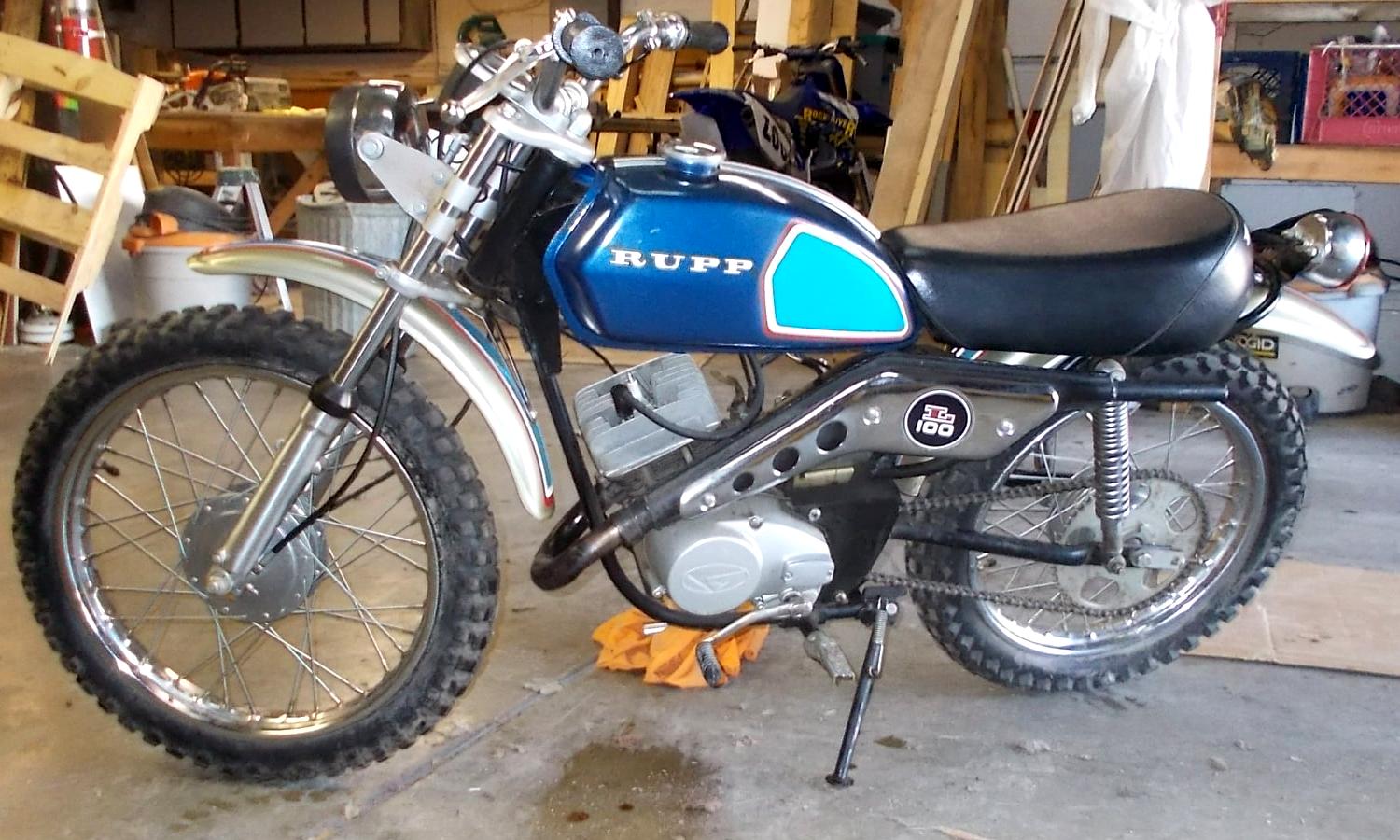
-
Also in 1973 Rupp introduced the SS-5 (the Rupp "Swifter Shifter").
A small cycle, equal in size to the RMT-80/L-80 but featuring a black Tecumseh HS50 5hp
and TC-1 drive system. Alloy front forks, alloy wheel hubs, silver in color with red/white/blk
accenting decals. Rear wheel is 16 inch and 17 inch front wheel.
This was the only large frame Tecumseh powered bike built by Rupp.
Dellorto MB22A or UA19s carburetor is used.
The Tecumseh engine is often HS50 model #67023 with a late 1972 serial number
(1972 was the first year for the Tecumseh HS50.)
Last bike with design help by Mickey Rupp.
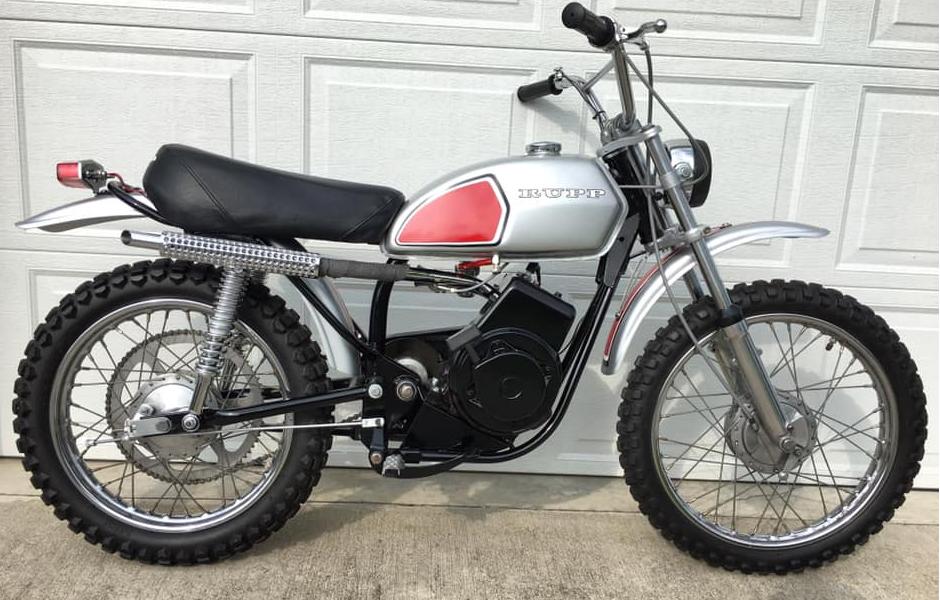
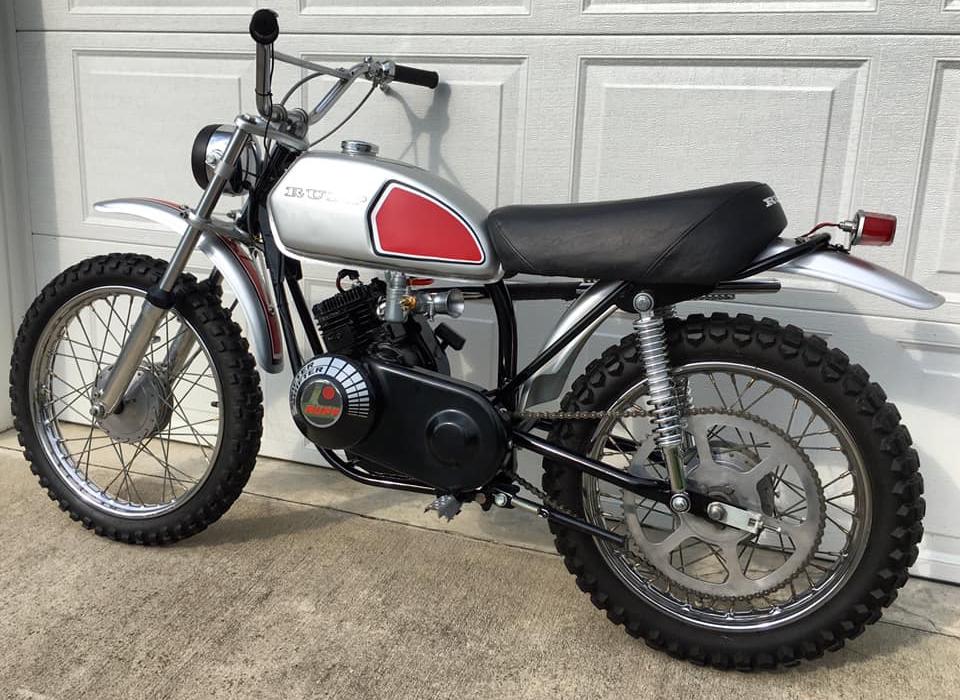
-
In 1975 the new MX-80 was introduced. It appeared as nothing more than a rehashed
combination of the RMT and L-80/L-100. Bike was basically a stripper version of all
Rupp's small cycles from years prior. Essentially a motorcross version of an RMT80
with a Fuji 80 motor, 4 speed manual trans,
alloy front forks, alloy hubs, no lights, green only. By this time financial problems for Rupp
had set in, this bike is believed to have been engineered for one reason:
to diminish existing inventories of spare parts from the previous model years.
1975 was the last year Rupp made any minibikes/cycles.
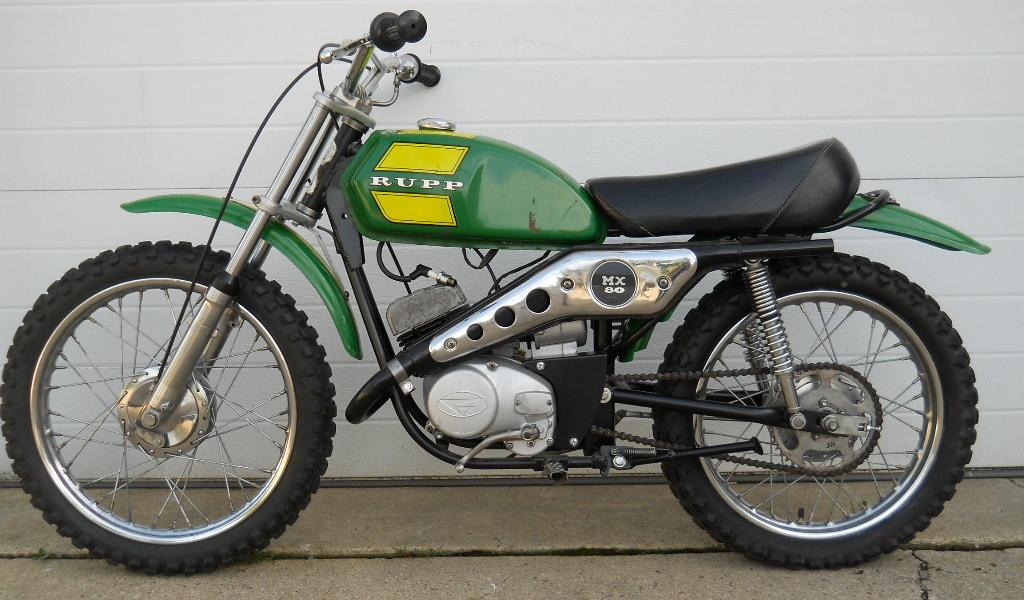
Rupp Gearing.
-
The gearing for Rupp mini bikes is important. If you gear too high,
there's not enough power. If you gear too low, not enough top end speed.
Personally I find 30 to 40 mph to be the top speed to hit with a
stock Tecumseh HS40 or HS50 engine (at 3600 rpm). With that in mind, this is what
the bikes use for gearing:
- 10" wheels 1970 (Roadster, Enduro, Scrambler): 11 tooth jackshaft, 54 tooth rear (4.9 to 1)
- 10" wheels 1971-1972 (Hustler, Scrambler): 11 tooth jackshaft, 54 tooth rear (4.9 to 1)
- 12" wheels 1972-1975 (Roadster, Enduro, Black Widow): 10 tooth jackshaft, 54 tooth rear (5.4 to 1)
Also check out these mini bikes too:
1970-1973 Speedway mini bikes
MTD mini bikes
Fox mini bikes


